Culture of Consciousness

Unearthing fashion’s history, labor practices to design a better future

 Designed by CAITLIN THIES
Designed by CAITLIN THIES
STUDENT MEDIA AT THE UNIVERSITY OF WISCONSIN TUESDAY, SEPTEMBER 13, 2022 · VOL 54, ISSUE 1 · BADGERHERALD.COM
Editor-in-Chief
152 W. Johnson Suite 202 Madison WI, 53703
3,500 copies
Published since Sept. 10, 1969
Find us online at badgerherald.com
Follow us on Twitter @badgerherald
Follow us on Instagram @badgerherald
Like us on Facebook facebook.com/badgerherald

Herald Editorial Herald Business
Janani Sundar
Managing Editors Audrey Thibert Caroline Crowley
Print News Editors Cat Carroll Kara Kneafsey
Digital News Editors Ben Cadigan Sophia Scolman
Science News Editors Lydia Larsen Scott McInerney
Science News Associate Sarah Matysiak
Campus News Associates Marion Elbow Maddie Bergstrom
City News Associate Lucy Wentink
State News Associates Aashna Sheth Ryan Mares
Features Editors Elise Fjelstad Maggie Degnan
Features Associate Abigail Leavins
Opinion Editors Celia Hiorns Fiona Hatch
Opinion Associates Emily Otten Jessica Lewin
Sports Editors Ian Patton Sam Harrigan
Sports Associates Mike Hall Ishaan Chadha
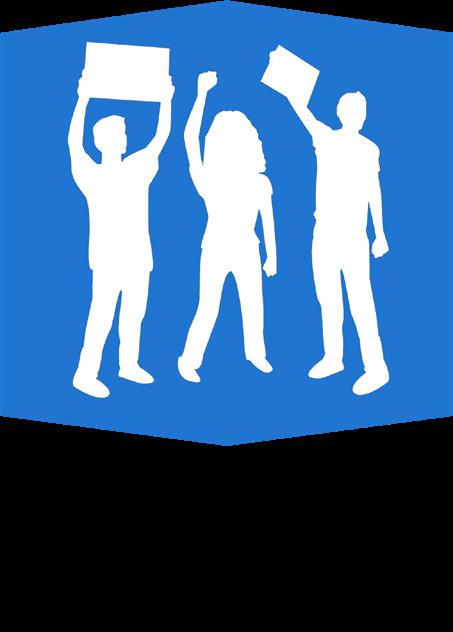
ArtsEtc. Editors Aidan Holmberg Nick Woodhouse
ArtsEtc. Associates Katherine Lyons Madeline Haines
Banter Editors Olivia Evans Phoenix Pham
Copy Chiefs Amalia Laskaris Samantha Klepfer
Photo Editor Abby Cima
Design Directors Charlotte Bellamy Corey Holl
Video Director Lucas Mair
Podcast Director Jeffrey Deiss
Herald Public Relations
Herald Advertising
Advertising Director
Parker Johnson
Board of Directors
Chair Katie Hardie Members Janani Sundar Audrey Thibert Caroline Crowley Olivia Evans Madison Hibner Maribel Barrera Parker Johnson Erin Gretzinger Arushi Gupta Phoenix Pham Maggie Degnan Elise Fjelstad Will Romano Anne Isman
MNOOKIN’S TENURE BEGINS
6 SPIDERS, SCORPIONS AND MORE 10
As the chancellor steps into her new role, she plans to focus on learning about the community, growing as a chancellor and listening to students
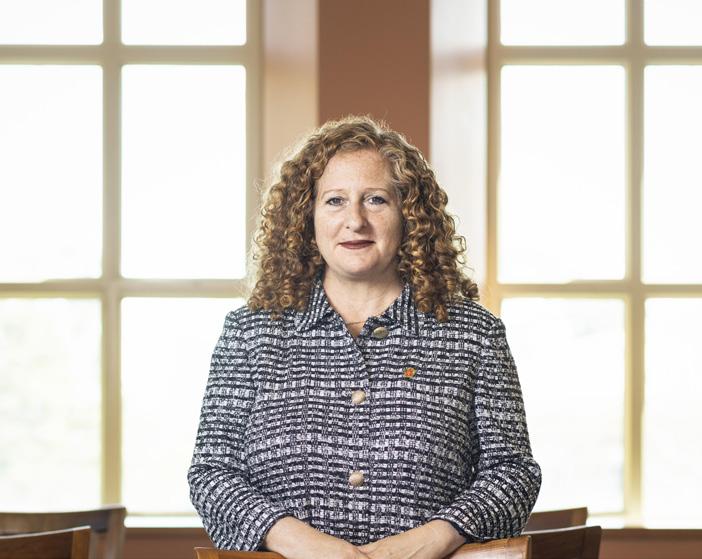
The Sharma lab uses AI and biology to study arachnids, including blind cave spiders and venomous scorpions
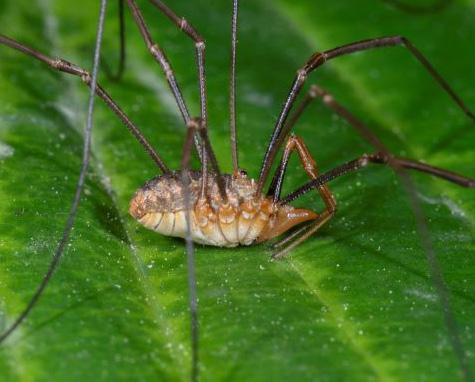
POINT-COUNTERPOINT: HOW TO APPROACH SUSTAINABIL ITY 15
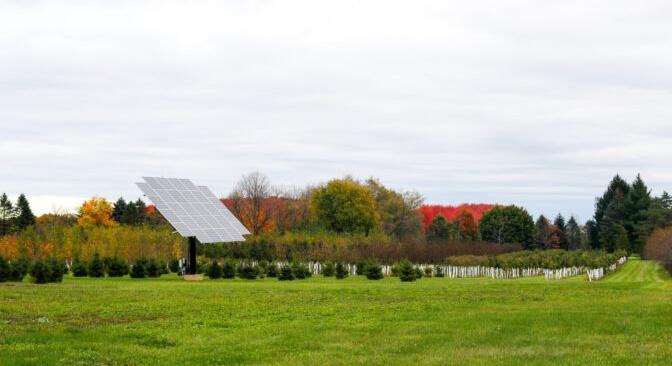
Two opinions on UW’s best route to sustainability: radical, fast-paced change led by the university or slower, student-led efforts to fight climate change?
THE MUST WATCH SPORTING EVENTS OF THE SEMESTER 19
With many exciting sporting events to watch out for this semester, here are our top five events spanning football, volleyball, soccer and hockey
Publisher Olivia Evans
Public Relations Directors Madison Hibner Maribel Barrera
1819 ARTS SPORTS
12 FEATURE 14 OPINION 22 BANTER 4 NEWS 2 • badgerherald.com • September 13, 2022
SIFTING & RECKONING
UW’S HISTORY OF EXCLUSION AND RESISTANCE
Chazen Art Museum presents new exhibit highlighting UW’s history of discrimination faced by students in academics, sports, housing, student life and fraternities. Read more on page 7.
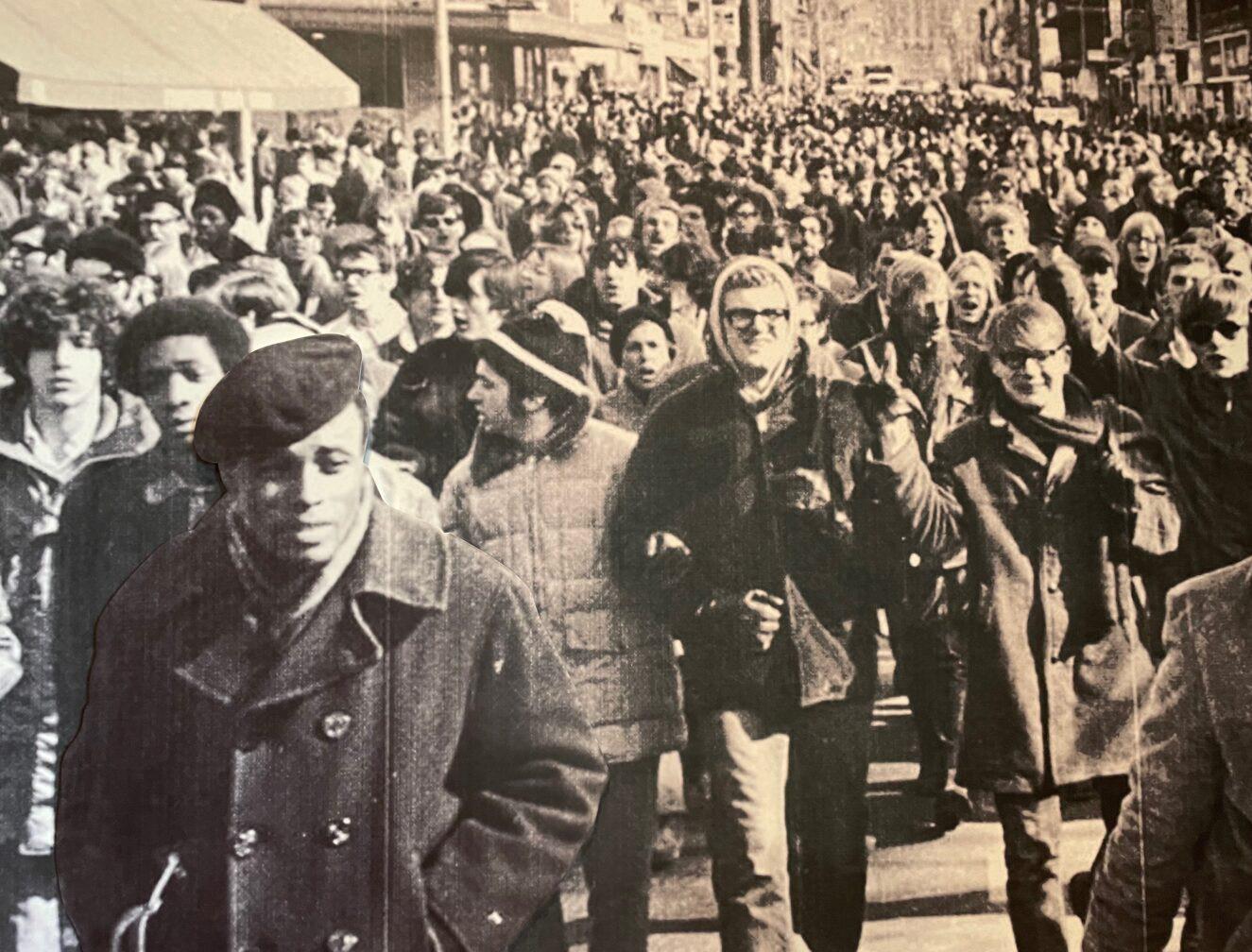

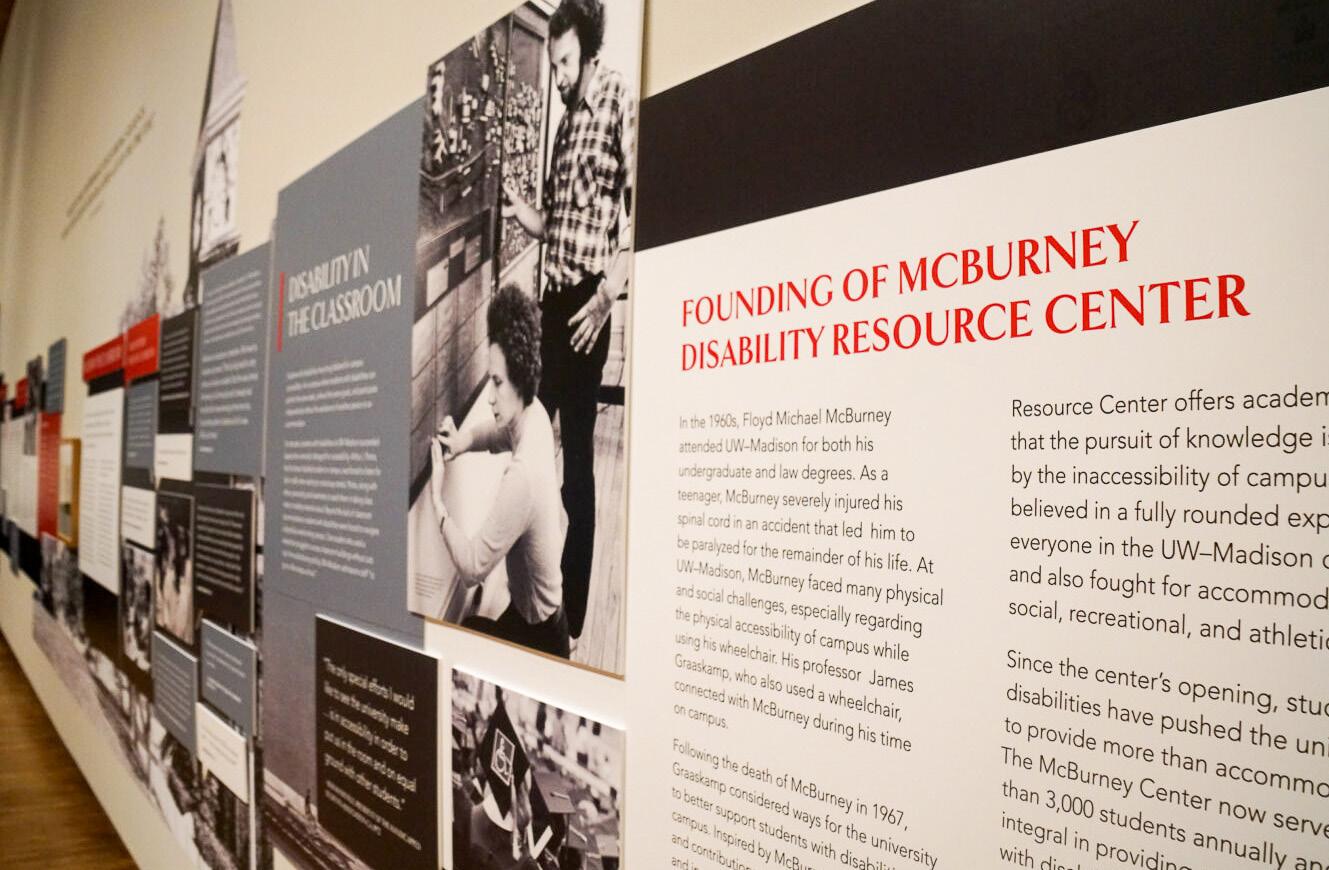
 PHOTO
PHOTO
facebook.com/badgerherald September 13, 2022 • badgerherald.com • 3
PHOTOS BY EDWARD KUSTNER AND BEN CADIGAN
UW Housing, Wisconsin Union raise hourly student wage
Wage increase encourages UW students to take on-campus jobs
by Grace Winter Reporter
University of Wisconsin Housing Department and the Wisconsin Union raised the starting wage for student workers from $12 to $15 an hour in an effort to attract more student workers. This increase in wages brings big implications for student workers, including more financial freedom and incentive to work on campus.
This signals a win for student workers who are constantly fighting for increased wages. In 2021, the Associated Students of Madison created the Student Workers’ Rights Committee to find solutions for existing labor issues on campus, as well as provide a way for students to address employment concerns, according to the ASM website.

Student worker Colby Belman, who works at the front desk at the Wisconsin Union Hotel, offered insight into how the wage increase will personally impact her life and willingness to work.
“The increased wage has made me more inclined to take up more open shifts because I am making more money,” Belman said. “It has also made me want to keep this job because the wages are so competitive with other jobs in Madison.”
Belman feels secure with finances since the wage increase. Now, she said she can purchase expensive, healthier foods, spend more money on clothing and go out to eat.
Wisconsin Union Hotel South employee Emily Ortiz shared that she started the job in the summer and planned to continue working into the fall regardless of the wage increase. But, the wage increase acted as an
added benefit for her.
“I wouldn’t say that this increase in pay drastically changed my quality of life, but it does provide me with a good amount of extra money to spend on groceries, gas and other essential expenses,” Ortiz said.
At UW, students have a lot of options for jobs on campus, according to an email statement from UW Housing Director of Marketing & Communications Brendon Dybdahl. By raising the wages, UW Housing hopes to incentivize students to work for them and remain competitive amongst other jobs.
In an email statement to The Badger Herald, Dybdahl described the recent wage increase as an investment in student workers.
“We rely greatly on our student employees to help us provide the high quality of services and facilities that our residents and guests expect,” Dybdahl said. “They do amazing work for us.”
Student jobs also provide a lot of opportunities for students, according to the statement. They act as a great way to gain valuable skills, meet new people, learn time management and make some extra money. In addition, students can work in a flexible, supportive environment.
Over the last several years, University Housing gradually started raising student wages, according to the statement. Wage increases are conducted in a responsible way so as to not significantly add to resident costs.
“Housing is a self-funded unit on campus, so wages and all other expenses must be covered by the funds we collect from our rent, dining operations and conference programs,” Dybdahl said. “We are a nonprofit entity, and all monies are invested back in our facilities and institutional mission. There is always a careful balance in our budgeting process between employee wages and what we then in turn need to charge our residents for room and board to cover expenses, and we’re very mindful of keeping costs reasonable.”
According to Dybdahl, recent years show first-year students seem less interested in working a student job. Those who do choose to work request fewer hours than students in the past.
But, with declining numbers of student employees and hours, UW Housing can now reallocate the student labor budget in ways they could not before, according to their statement. As a result, students can now make $15 an hour.
“We hoped to eventually get to a $15/hour student wage, and the lower staffing numbers made it possible this year without having to make any other adjustments,” Dybdahl said.
 The change in student wages was made possible by lower staffing numbers, according to an UW housing official.
working on campus
The change in student wages was made possible by lower staffing numbers, according to an UW housing official.
working on campus
NEWS @badgerherald 4 • badgerherald.com • September 13, 2022
AINA MOHD NASER. THE BADGER HERALD. Students
will now earn $15 per hour. EDWARD KUSTNER. THE BADGER HERALD.
Wisconsin Suicide and Crisis Lifeline implements 988 hotline
by Julia Gozdziewski Reporter
Wisconsinites can now dial 988 to be connected with a 24/7 crisis counselor. This number, the 988 Suicide & Crisis Lifeline, is the new name for the 2005 National Suicide Prevention Lifeline.
The 988 Suicide & Crisis Lifeline launched July 16 as an effort by Wisconsin’s Suicide and Crisis Lifeline in conjunction with the Substance Abuse and Mental Health Services Administration to streamline crisis resources, according to the National Academy for State Health Policy.
Here’s how it works — Wisconsinites can contact the 988 Lifeline by call, text or the online chat feature. Next, the person will receive a response with options for Spanish speakers or veterans. Then, the caller will be connected with a counselor.
From there, most callers receive support and
de-escalation help along with local referrals. If the counselor feels the caller poses a high concern of imminent risk of self or others, that person will receive a required wellness check from law enforcement. If the counselor feels the caller poses an imminent risk to themselves or others, they will receive a medical response along with required emergency law enforcement, according to the Crisis Services website.
If a call, text or chat message is not answered by the Green Bay crisis center, it will roll over to a national backup system, according to Spectrum News. But the goal is for Wisconsin-based counselors to be on the receiving end as much as possible because they are most knowledgable about local communities and resources.
The push for an easier-to-remember lifeline number stems from the fact that the majority of mental health emergency calls are currently
dialed to 911. But most officers are not trained to address these emergencies, Wisconsin Department of Health Services crisis services coordinator Caroline Crehan Neumann said.
As a result, the police response can be — and often is — traumatic for callers. The connection between mental health emergencies and law enforcement currently serves to stigmatize mental illness, Neumann said. By doing so, people are further pushed away from accessing mental health resources that would alleviate their struggle.
Though a response by law enforcement is necessary in cases where an individual is at risk of hurting themselves or others, Neumann said, this does not apply to the majority of callers.
“We don’t want law enforcement to handle these situations [and] law enforcement does not want to handle these situations,” Neumann said.
Nationwide, the vast majority (98%) of those
who utilize the free and confidential support system do not require emergency help, according to SAMHSA. Instead, trained crisis center counselors are able to provide relief for almost all who call the Suicide and Crisis Lifeline.
Ultimately, Neumann said the goal of the number change is to work toward 988 becoming as synonymous with mental health services as 911 is for fire and police services and, eventually, create a separation between the two services.
The transition to three digits was also an effort to increase awareness about the lifeline and its extensive mental health resources, according to SAMHSA.
According to Neumann, the publicity surrounding the number change has been instrumental in accomplishing this goal. According to the United Nations Children’s Fund, this is especially the case for young adults who, after experiencing emotional distress and social anxiety from the COVID-19 pandemic, are now entering the workforce.
While UW promotes its own mental health resources, the push by SAMSHA to extend mental health access makes crisis resources available to students and will help students once they leave campus.

“While I think that UW-Madison does a good job of promoting mental health services offered through UHS, I think a lot of students graduate without an understanding of how to access mental health resources outside of a campus environment,” UW junior Jenna Truck said.
The bipartisan National Suicide Hotline Designation Act, created by Sen. Tammy Baldwin and passed by Congress in 2020, brought the 988 Lifeline to fruition.
In addition to a number change, the lifeline also received a $1.7 million federal grant that has been used to hire more counselors and expand the call center, according to Wisconsin Public Radio. This was especially necessary as the number of calls to Wisconsin’s lifeline received over 4,400 calls in its first month of operation, according to the Green Bay Press Gazette.
In the future, however, Neumann aspires to see the Suicide and Crisis lifeline combined with other needed mental health services.
Wisconsin currently employs crisis mobile teams to provide in-person visits by a mental health professional, Neumann said. These teams are not available 24 hours a day nor seven days a week. Immediate in-patient treatment is likely to be acquired only in a hospital setting, even if an individual is assisted by a crisis mobile team, Neumann said.
Neumann and other mental health advocates are therefore striving for a streamlined response to mental health crises — one that would fuse together the process of calling, receiving inperson assistance and, if needed, a place to go outside of the caller’s residence.
September 13, 2022 • badgerherald.com • 5 NEWSfacebook.com/badgerherald
Wisconsinites can now call, text or online message 988 for crisis resources
The change in hotline number is intended to create more accessible mental health options for emergencies. AINA MOHD NASER. THE BADGER HERALD.
UW Chancellor Mnookin begins tenure at UW, collaboration efforts
by Annie Pulley Reporter
Newly appointed University of Wisconsin Chancellor Jennifer Mnookin started her tenure as UW’s 30th leader on Aug. 4.
In a tweet, Mnookin summarized her first day as “exhilarating” and emphasized her commitment to learning, growing and listening to the student community. In a May 2022 press conference, Mnookin said that she would first focus on becoming acquainted with UW culture before enacting change.
“What I also know is that I need to come, listen and hear how my ideas interact and intersect with exciting initiatives already taking place,” Mnookin said in the press conference.
Associated Students of Madison Chair Ndemazea Fonkem said she appreciates
Mnookin’s enthusiastic efforts to interact and bond with students thus far. The chancellor has worked collaboratively with ASM, speaking with the students regularly.
“The chancellor is making a point to interact with students who otherwise would have no idea that she existed,” Fonkem said. “I think I personally have interacted with her four or five times.”
Mnookin is succeeding in her efforts to be present and has made a concerted effort to meet with student government and hear everyone’s opinions, according to Fonkem.
On her first day, Mnookin met with media outlets, leaders from UW’s 13 schools and colleges, faculty and students, according to UW
News.
According to University Communications Director of Media Relations Kelly Tyrell, Mnookin is committed to learning what it means to be Badger and to subscribe to the Wisconsin Idea — the belief that the boundaries of the university extend past academics and into the greater community.
“I know that she is deeply interested in really learning more about Wisconsin and learning more about the university,” Tyrrell said. “As the state’s flagship university, we have a deep responsibility to serve the state of Wisconsin and to serve our community, and I think that’s something she takes very seriously.”
On her second day, Mnookin met with local
elected officials including Rep. Francesca Hong and Dane County Board Chair Patrick Miles to discuss university, regional and statewide goals. Mnookin also toured the South Madison Partnership and the Urban League of Greater Madison, according to UW News.
So far, Mnookin has followed through on one of the primary objectives she laid out in a livestreamed interview with the Wisconsin Alumni Association in June — promoting excellence, affordability and accessibility.
UW sits beyond national averages, with student loan debt down from national averages. Two-thirds of UW students graduate debt free — in contrast to only 52.8% of undergraduates nationwide owe money, according to the Education Data Initiative.
“I know that Chancellor Mnookin wants to make certain that UW-Madison continues to provide the best educational experiences for students at the lowest possible cost,” Tyrell said.
Mnookin plans to build on this progress and strengthen Bucky’s Tuition Promise — a program that provides scholarships and grants to Wisconsin residents whose households earn $60,000 or less, Tyrrell said.
The new chancellor’s efforts to make higher education more affordable will benefit students for years to come, according to Fonkem.
Mnookin has also made strides in collaborating to integrate UW throughout the greater Madison community. On Aug. 11, she met on Madison’s South Side with the founder of The Center for Black Excellence and Culture Rev. Alex Gee. The center is projected to be a nucleus for people striving for Black excellence and Gee hopes to collaborate with UW on research conducted at the center, according to UW News.
That same day, Mnookin also visited One City Elementary School, a tuition-free public charter school in Madison enabled by the University of Wisconsin System’s Office of Educational Opportunity.
Mnookin will build on former Chancellor Rebecca Blank’s work, furthering initiatives such as the Public History Project, which seeks to elevate historically marginalized voices and educate students and alumni about the full picture of the university’s past, both successes and failures, Fonkem said.

Fonkem also said Mnookin understands achieving diversity goes deeper than stock photos depicting a diverse campus environment.
It will take more than a month to evaluate Mnookin’s approach to the office, according to Fonkem. But Fonkem is hopeful that Mnookin will serve the students and faculty of UW and citizens of Wisconsin well.
“She cares about our campus being honest about what it is and taking the steps to improve that, and I like that initiative,” Fonkem said. “I’m hopeful.”
Mnookin aims to promote excellence, affordability, accessibility
Chancellor Mnookin emphasized her commitment to learning about the community, growing as a chancellor and listening to students.
NEWS @badgerherald COURTESY UW COMMUNICATIONS.
MAX S GERBER. PHOTO
6 • badgerherald.com • September 13, 2022
New Chazen exhibition highlights UW’s history of discrimination
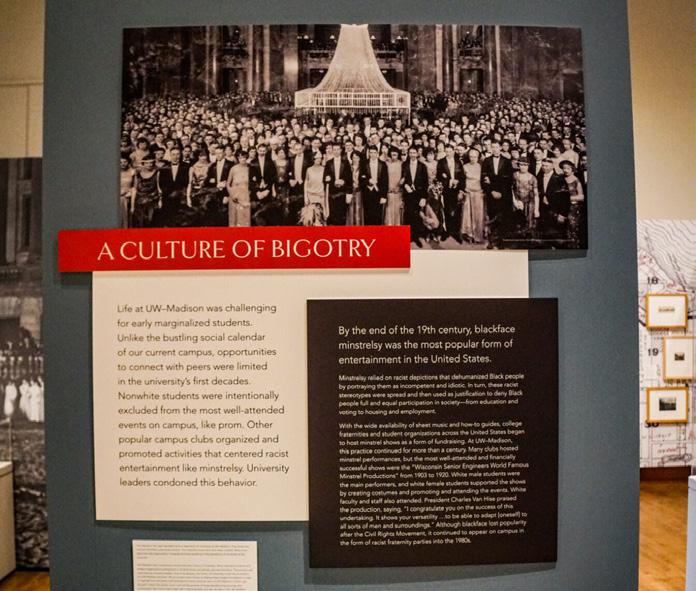 by Ben Cadigan Digital News Editor
by Ben Cadigan Digital News Editor
The University of Wisconsin’s Public History Project unveiled its exhibition “Sifting and Reckoning: UW–Madison’s History of Exclusion and Resistance” Monday at the Chazen Museum of Art.

The exhibition focuses on the stories of people who faced discrimination on campus, with stories from the 1860s to the present day. These stories and artifacts are all from the UW Archive, with three pieces from the Wisconsin Historical Society, according to Public History Project Director Kacie Lucchini Butcher.
The stories in the exhibition cover discrimination faced by students who are Jewish, African-American, Mexican, Chinese, Hmong, Indigenous and gay, as well as women and students with disabilities. This discrimination was prevalent in academics, sports, housing, student life, fraternities and more.
But the exhibition is not all negative. It also highlights student protests, landmarks and cultural association openings.
“A lot of these older stories that we found in the archives, these people, these communities were banded together to fight for change and get these organizations that have lineages to the [Multicultural Student Center] on campus,” Public History Project Assistant Director Taylor Bailey said.
UW has funded the Public History Project since 2019. The project originated from a study group tasked with two objectives — looking into two organizations bearing the name of the Ku Klux Klan on campus in the 1920s and investigating the history of systemic discrimination on UW’s campus. Former Chancellor Rebecca Blank commissioned the project due to the results of the study group, according to the Public History Project’s website.
The project asked UW students to tell their stories of discrimination on campus, some of which are displayed within the exhibition. Butcher said the project also asked students what being a Badger means to them and if they feel welcomed by this identity.
“The first 20 responses that I got from students ... were so complex, complicated, nuanced and interesting,” Butcher said. “I think whether you’re a person who does feel really confident calling yourself a Badger or you’re somebody who doesn’t, seeing each other’s responses will be an important part of continuing that conversation
and giving space to that conversation.”
The exhibition has several spaces for visitor participation, especially from students. There is a space for visitors to answer the question “Do you call yourself a Badger? Why or why not?” as well as a space for visitors to commit to change for the future or to discuss what UW needs to change to help diversity.

Butcher plans to use these two visitor-led spaces as another source of data for next steps, as well as to encourage visitors to interact on a deeper level with the exhibition.
“I hope people are inspired not only by the communities that are formed, by the actions taken, but [also] by a lot of the individuals and the vision that they had, for how they could make the university better and how they went out and did it,” Butcher said.
The exhibition features several artifacts that perpetuated discrimination at UW, including the pipe of peace, a commencement tradition between the 1890s and the 1940s. The pipe, featuring colorful ribbons and exaggerated Indigenous imagery, was handed down from the senior class to the junior class each year. The pipe represents early discrimination against Indigenous people while on Ho-Chunk land, according to the placard at the exhibition.

UW Chief Diversity Officer LaVar Charleston said the exhibition gave him chills — it demonstrates the progress UW has made but acknowledges there is still work to be done.
“That is the nature of history and that is how we can learn and grow and the understanding uncovered adds so much value to our understanding of what this place is and why it’s so special,” Charleston said.
Charleston said visitors should not feel bad about what they experience in the exhibition but should recognize it and look towards the future of change in diversity and inclusion in UW.
The exhibition will run at the Chazen Art Museum until Dec. 23, after which it will be available online on the Sifting and Reckoning website.
“I just want people to come to our exhibit, visit our website or come to a lecture series,” Butcher said. “[I want people] to engage with us, to engage with the histories on the wall and the stories, to learn new things, to ask really crucial and critical questions about the university’s past and to participate in this really unique moment that we have right now to have time and space to reflect on our past and how it intersects with our present.”
Exhibition covers past discriminations faced by students, highlights protests, landmarks, cultural association openings
EDWARD KUSTNER. THE BADGER HERALD.
The peace pipe is displayed as an example of early discrmination of Indigenous people while on Ho-Chunk land.
EDWARD KUSTNER. THE BADGER HERALD.
EDWARD KUSTNER. THE BADGER HERALD.
Stories in the exhibition feature stories about students, the history of discrimination on campus and more.
EDWARD KUSTNER. THE BADGER HERALD.
The Sifting and Reckoning exhibit is located in the Chazen’s Pleasant T. Rowland Gallery.
September 13, 2022 • badgerherald.com • 7 NEWSfacebook.com/badgerherald
Fostering Success expands, strengthens communities
by Cat Carroll Print News Editor
The University of Wisconsin system is expanding its Fostering Success program to additional campuses this fall to help students who have been in foster care, homeless or orphaned achieve their goals of completing secondary education, according to the Fostering Success website.
The program, which began at UW-Stout, will now also support students at UWLaCrosse, UW-Milwaukee, UW-Whitewater, UW-River Falls and UW-Eau Claire, according to Wisconsin Public Radio.
Fostering Success launched in 2013 in an effort to provide additional support to these underrepresented students who had experience in foster care, according to Fostering Success Advisor Gail Mentzel.
The Fostering Connections to Success and Increasing Adoptions Act of 2008 was put in place to improve education outcomes for children in foster care but once outside the system, these children are at a disadvantage. There are programs in place
around the U.S. that aid these students in achieving post-secondary degrees, but they are often unbeknownst to students who qualify.
According to Mentzel, Fostering Success students are committed to their education but often need more support than their peers. Once students have a person of support, the program is shown to be successful.
“The students that I work with at Stout are truly extraordinary in their commitment to being in school and their ability to balance an accelerated trajectory to adulthood,” Mentzel said. “When they age out of care, they may be considered adults and are on their own without the traditional family support net some of their peers may have. To show up in my office just demonstrates a lot of hard work and determination to be in college.”
A study done by Casey Family Programs found that only about 2% of young people from foster care obtained a bachelor’s degree, in contrast to 24% of adults in the general adult population. Many students who have
lived in foster care have goals to pursue a higher education but often lack the resources and support to be successful, according to Mentzel.
According to Mentzel, Fostering Success wants everyone to have an equitable opportunity for college education. The program is important not only for underrepresented students but for greater communities, too.
“This is a population in Wisconsin and across the country that we need to support to better,” Mentzel said. “We need their intellect and their passion and their innovation to make our communities and society better.”
The Fostering Success program ensures students are successful by providing support in areas beyond academics. Students are offered cooking lessons, driver’s education assistance, emergency fund assistance, summer camp advisor jobs and more, according to the Fostering Success website.
In combination, this assistance builds
a community that is critical for students, according to Fostering Success lead peer mentor and peer advocate Olivia Johnston.
As a first-year student at UW-Stout, Johnston was urged to become a member of Fostering Success, but felt it wasn’t her place. After becoming familiar with the staff of the program, Johnston said she felt compelled to join.
“It was a great opportunity and I’m so glad I actually joined, given that I was a little scared at first,” Johnston said. “It made me feel comfortable and enabled me to be the student that I was in college.”
Johnston graduated from UW-Stout with a B.S. in Business Administration in spring 2021, but remains active with the program, doing volunteer work and speaking on panels about the importance of Fostering Success.
Johnston and some of her fellow Fostering Success peers spoke on a panel in February 2020, telling their stories to Wisconsin Gov. Tony Evers and calling for the expansion of this program.
“Gov. Evers sat and listened to the students share their experiences and how they arrived at Stout and how the program had supported their transition and ongoing retention and support at Stout,” Mentzel said. “He was very interested and very supportive of the work that we were doing at Stout and wanted to see that expanded across the state.”
With the COVID-19 pandemic, Mentzel and other members of the Fostering Success team faced concerns that the allocation of resources for the expansion of this program would be forgotten about, Mentzel said.
Despite interruptions caused by the pandemic, the 2021-23 state budget allocated $750,000 for schools within the UW System to support and offer Fostering Success, according to Wisconsin Public Radio.

“What’s great about this is that our students from foster care shouldn’t all have to attend Stout to get the support they need,” Mentzel said. “Students can now choose from eight other campuses and Stout.”
Funding for the expansion of Fostering Success will allow students to attend the UW System school that best suits their needs — geographically and academically, Mentzel said.
According to Johnston, Fostering Success can be a life-changing experience for students.
“I’m excited that the experience I got to have at UW-Stout will now be universal across the UW System as it created an opportunity for [a] community that I did not have before,” Johnston said. “It really helped me all around, which I know is going to help many, many students who were in the same position I was to have a great educational path.”
Program will support students across UW System who have been in foster care, homeless or orphaned
The Fostering Success Program will support students through their secondary education on several UW System campuses.
MAIZONG VANG. THE BADGER HERALD.
NEWS @badgerherald
8 • badgerherald.com • September 13, 2022
STEM students with disabilities face extra barriers in earning degree
Inability to accommodate disability restrictions create ‘unwelcoming’ culture, leading to underrepresentation in STEM field
by Sarah Matysiak Science News Associate Editor
Note: This story uses person-first language (“people with disabilities”) and identity-first language (“disabled people”), per the mixed use in various interviews. Please note that people may prefer either term or different terms.
With a research expenditure of over $1 billion annually, it is no surprise the University of Wisconsin ranks eighth in the nation in research output. Providing proper training is vital to creating a safe space for all researchers. But for people with disabilities who require additional accommodations, access to equitable resources in labs is limited and most lab spaces are not made to meet these needs.
The Americans with Disabilities Act “prohibits discrimination against individuals with disabilities in all areas of public life, including jobs [and] schools.” In reality, massive barriers still exist, making participation extremely difficult for people with disabilities, especially in STEM.
McBurney Disability Resource Center program aide Katie Sullivan, who studies communication sciences and disorders and health promotion and equity, sees these barriers all around her.

“Disabled and chronically ill students are wholly underrepresented in STEM,” Sullivan said. “Having a disability and trying to work in STEM is highly stigmatized because there’s this notion that if you’re disabled, you’re not cut out to work in medicine or work in research or be involved in science.”
In 2021 the Bureau of Labor Statistics found that only 5.5% of men and women in life, physical and social science, architecture, engineering, computer and mathematical occupations had disabilities. The National Institute of Health found that between 1999 and 2019, the percentage of people with disabilities in STEM grew a meager 3% — from 6% to 9%.
Much of the disparity stems from access to postsecondary education. There is a large discrepancy between those with and without disabilities who have completed a bachelor’s degree. In early 2022, of people -25 and older with a disability, only 21.1% had a bachelor’s degree or higher, according to BLS. Nearly double the amount without a disability completed at least a bachelor’s degree, according to BLS.
At UW, students with registered disabilities can apply for accommodations provided by the McBurney Disability Resource Center. For many, the center provides extended time and smaller groups
for testing, advanced access to course materials and adaptive technology to help with note-taking, according to Sullivan. Covering such a broad range of services is critical as McBurney supports over 3,600 students in differing areas of study.
While McBurney is great for accommodating undergraduate students, third-year Ph.D. student in the Department of Integrative Biology Nathan Anderson has had a different experience as a UW employee and Ph.D. candidate.
“McBurney only covers my accommodations as far as they go into classes that I take,” Anderson said. “As far as
accommodations within my capacity as an employee of the university — so accommodations in the actual lab space where I work — have all been coordinated with the department disability representative.”
Anderson started studying life sciences upon his acceptance into graduate school. As an undergraduate, he studied mathematics, which didn’t require any wet lab work.
Still, having research experience was important to Anderson as an undergraduate, but he found it difficult to find a lab willing to accommodate his
service animal.
“I do computational work because that’s really all that’s open to me,” Anderson said. “There’s a lot of options that are not open to me in the STEM field.”
Though Anderson found a research job that addressed his needs, the same doesn’t go for everyone. He said people with certain disabilities cannot teach or participate in some microbiology and chemistry labs. Specifically, there are sterility issues and strict lab protocol when it comes to having a service animal.
Anderson and Sullivan believe representation of students with disabilities is so small in the STEM field because of exclusions. For other students with disabilities who would like to study STEM, getting a degree in their area of interest might not even be plausible.
What many fail to realize, however, is that much of this negative perception of being disabled in a STEM field comes from society failing to recognize the barriers it has erected surrounding the disabled community, according to Sullivan.
For example, the American SpeechLanguage-Hearing Association (ASHA) has obstacles that make it difficult for disabled students like Sullivan — who hopes to go into speech and language pathology — and other students with disabilities to pursue this career path professionally.
“[ASHA has] these parameters that you need to be able to meet to get into grad school,” Sullivan said. “You must be able to lift this much, you must be able to run, walk, see, hear, things like that.”
Additionally, life science research for students with disabilities can be very “unwelcoming” and “competitive,” Anderson said.
If there were a larger number of people with disabilities in STEM, it would help curb negative perceptions associated with disabled people by making it common to see accessible features in society, Sullivan said.
“Engineering and how things are designed and made should really be centered around accessibility and the disability experience,” Sullivan said. “When you make something accessible, you’re not cutting non-disabled individuals off from using that.”
As for students like Anderson and Sullivan, being disabled in STEM brings much-needed transparency to the issue.
September 13, 2022 • badgerherald.com • 9
SCIENCE NEWSfacebook.com/badgerherald Lab accommodations for people with disabilities include buttons for a service dog to press in case of an emergency. LYDIA LARSEN. THE BADGER HERALD.
The Lab Report: Sharma Lab studies biodiversity of arachnids
 by Kelli Marschall Science News Reporter
by Kelli Marschall Science News Reporter
The Sharma Lab at the University of Wisconsin Department of Integrative Biology uses evolutionary biology to discover new species and study the molecular basis for biodiversity. This work allows researchers to pinpoint the exact genes that cause dramatic physical differences between species.
Headed by Integrative Biology Department associate professor and principal investigator Prashant Sharma, the lab aims to further understand the evolutionary relationship between scorpions, spiders and other arachnids and how that compares to other groups of animals.
According to the Sharma Lab website, the project analyzes the specimens’ genomes and constructs a phylogenetic tree — a visual representation of how species are related. This complete arachnid phylogeny is an important tool for researchers to understand how mutation results in new species and help
classify species discovered in the future.
The findings of this study are relevant to more than just arachnids. Any small discovery in biodiversity is a victory for the entire integrative biology field, Sharma said.
“[This lab] focuses on what biodiversity looks like and how it’s maintained on the molecular level — the specific gene products that cause these different phenotypes and how they affect our broader understanding,” Sharma said. “We don’t really know what species are important to prioritize for conservation, if we don’t know what’s out there. That’s why this research is so important.”
While evolutionary biology is an extensive field, many students have very little experience with it. As was the case for undergraduate Hugh Steiner, who has worked in the Sharma Lab for a year and a half. Steiner said he was inspired to pursue
research in the lab after having Sharma as a professor, igniting his interest in evolutionary biology and molecular phylogenetics. In the future, Steiner said he would like to continue this line of research, which he never considered before meeting Sharma.
Within Sharma’s lab, Steiner applies molecular phylogenetic techniques to identify and classify new species of blind cave spiders taken from 44 cave sites throughout the Levant — a large area in the eastern Mediterranean, including Israel, Palestine and Syria. Despite many of these species being physically indistinguishable to the naked eye, Steiner used molecular data to prove the species are in fact new and separate.
After his work on the species discovery project, Steiner said he shifted his focus from the more computational side of research to molecular experiments.
“I decided to try my hand at evolutionary development research instead of just taxonomy,” Steiner said. “There’s an entirely different set of research techniques we use in the lab that I’ve barely even explored yet.”
Evolutionary development, another facet of the Sharma Lab’s research, uses genetic data to identify the exact genes that cause differences between species, working backwards to identify new targets for research, according to BioMed Central. Once promising genes are identified, researchers categorize the function by removing the gene product and observing the changes in appearance and behavior. Researchers can simulate evolution by identifying which specific genes in arachnids cause visible differences between closely-related species.
The Sharma Lab has also begun genetic analysis on scorpions by using machine learning to predict which scorpion species’ venoms may be medically relevant. Lab members then analyze these gene products and test venoms for antibacterial or even tumor-reducing properties, Sharma said.
According to Sharma, new antibiotics that may be discovered using this research are of particular interest because bacteria adapt to frequently-used antibiotics, leading to anti-bacterial resistance. Any new antibiotic discovered will give doctors new tools to combat infections.
“We know that some of these venoms have therapeutic properties, but it’s a scavenger hunt to see which are which,” Sharma said. “[Artificial intelligence] allows us to link [genetic] sequences of known venoms with available functional data to predict what peptides contained in arachnid genomes are promising.”
Evolutionary biology involves analysis of massive data sets, with each species’ genome containing billions of base pairs, according to Sharma. Even a small sample size is too large for a human to analyze by hand. Combining existing understanding of genetics and molecular physiology with the unparalleled processing power of artificial intelligence has completely changed the field of evolutionary biology.
Sharma said machine learning has facilitated much of his recent research. In turn, each biological discovery gives future programs additional data to use, further honing their research techniques.
“We don’t know what’s important if we don’t know what’s out there,” Sharma said.
“Using these computational tools, we’re answering questions that couldn’t even be asked 20 years ago. We are in the middle of a revolution not just in [biological research but also in how we ask these questions.”
Sharma lab studies evolution, development of arachnids to better understand biodiversity, using molecular, computational techniques
The Sharma Lab analyzes specimens’ genomes of various arachnids, including blind cave spiders, venomous scorpions and daddy longlegs as the one seen above.
CAITLIN BAKER. PHOTO COURTESY THE SHARMA LAB.
September 13, 2022 • badgerherald.com • 10 SCIENCE NEWS @badgerherald
Research labs struggle to sustainably manage waste
UW labs using plastics have limited sustainable disposal methods
by Lydia Larsen Science News Editor
An epicenter of groundbreaking research, the University of Wisconsin constantly produces new findings in many areas, from chemistry to plant pathology. But while these labs vary in research topics, they are united by the large amount of plastic waste they produce.
According to the UW physical plant website, 5,000 tons of waste and 4,000 tons of recyclable materials are transported off campus every year. While it is unclear what percentage of this waste is produced by campus research labs, studies indicate that research labs produce large amounts of plastic waste globally.
UW has systems in place to manage disposal of other dangerous or hazardous materials produced by labs. According to the UW environmental health and safety website, there are systems in place for labs to dispose of animals, biological waste, chemical waste and radioactive waste. There are limited resources, however, for more mundane lab waste, such as pipette tips, petri dishes and disposable gloves.
Research scientist Ming-Yi Chou works for the Koch Lab at UW and studies how to best control turfgrass diseases. He said it’s difficult finding ways to dispose or recycle the plastic waste his lab accumulates.
“There is no clear direction of how to recycle them,” Chou said. “The information is probably online but not here. Where do we dispose of those? In the end, what we can do is dump them into a dumpster with a broken heart.”
In an effort to raise awareness, the Office of Sustainability has offered a Green Labs certification for the past three years. To earn this certification, Office of Sustainability interns work with a member of a research group to meet sustainability targets specific to each lab. These target range from saving energy to finding more sustainable ways to source certain materials or reduce the waste they produce.
When Chou was growing up in Taiwan, sustainability played a big role in his education. When he arrived in the U.S., using disposable plastics in his lab was easy and convenient for a while, but it eventually started to wear on him. In 2020, he worked with the Office of Sustainability to become Green Lab certified.
“We reuse anything we can,” Chou said. “A lot of times, things are labeled
as disposable, but if you look into the material, they can be re-autoclaved. We’ll keep those and clean them and reuse them.”
Chou said there is a lack of resources available for managing the plastic waste his lab accumulates. When he wants to recycle the plastic bags accumulated in the lab, a lab member must arrange transportation to a grocery store to recycle them.
Despite UW’s systems for managing chemicals and hazardous materials, labs are often on their own when dealing with plastic waste, Chou said. Recently, when Chou cleaned out the lab, two large buckets full of plastic waste ended up in the garbage.

This trend of excessive waste is prevalent beyond UW, too. In 2015, a microbiology lab at the University of Exeter weighed all their bioscience department’s annual plastic waste and used that data to estimate the amount of plastic waste used in laboratories across the world. Their calculations showed that research labs produce 5.5 million tons of plastic waste a year.
Labs can work to be more sustainable in multiple ways, including energy, water use, purchasing and plastic use, Office of Sustainability Intern Program Director Tim Lindstrom said.
There are a few barriers preventing big change to the amount of plastic waste research labs accumulate. While researchers may be aware of the plastic they consume, they often are simply stretched too thin to manage sweeping changes in their lab, according to Lindstrom.
Additionally, changes to improve a lab’s sustainability don’t necessarily directly benefit the research group, making it difficult to prioritize sustainability, Campus Resource Manager Travis Blomberg said.
“While you have a lot of people that care about [sustainability] and want to do the right thing, they also want to know ‘what’s
Plastic waste is abundant in research labs across campus.
in it for me?’” Blomberg said.
For example, labs use a lot of energy. But if a lab doesn’t need to pay directly for the energy, there isn’t a lot of incentive to improve their energy use. They see these steps to become more sustainable as extra work, Blomberg said.
According to Lindstrom, labs are also constrained by the type of research they perform. Researchers often require specific materials and these conditions leave very little room to maneuver within those requirements.
Additionally, labs could be motivated to find a more sustainable vendor, but there may not be one that meets their needs
and has a university contract. Researchers might want to recycle their disposable lab gloves, but there is no universal solution for that problem, Lindstrom said.
There needs to be a systematic approach to the plastic waste problem in labs, Blomberg said.
Recently, up-and-coming organizations have been trying to find different ways to solve the problem of lab plastic waste. The company Polycarbin aims to use old pipette tip boxes and recycle them into new plastic lab products. The company Kimberly Clark will recycle uncontaminated lab gloves, but researchers need to buy gloves from their company.
While a step in the right direction, these solutions put a big workload on researchers and require reconsideration at a higher level, according to Lindstrom.
“Whether it’s lab employees or whether it’s students on the UW campus, or anyone, for waste management and sustainable waste management, the responsibility is so often placed on the consumer and that is an unfair system,” Lindstrom said.
“In the end, what we can do is dump them into a dumpster with a broken heart.”
- Ming-Yi Chou
LYDIA LARSEN. THE BADGER HERALD.
September 13, 2022 • badgerherald.com • 11 SCIENCE NEWSfacebook.com/badgerherald
Culture Consciousness: of
by Maggie Degnan Features Editor
When Yvett Sanchez enrolled at the University of Wisconsin, she wanted to be a fashion designer.
But by the time the COVID-19 pandemic sent students to class remotely, her aspirations had changed.
“I just don’t find making clothes as interesting anymore,” Sanchez said. “I’d rather just be more behind the scenes working with the logistics, sourcing and helping in the product development stages.”
Instead of completely switching her major from textiles and fashion design, Sanchez opted to add a certificate in sustainability to her studies.
Sanchez has had an interest in sustainability since high school — particularly in sustainable fashion after viewing “The True Cost,” a documentary that showcases harsh conditions in India’s cotton fields and in the garment factories of Cambodia and Bangladesh.





It was this passion for ethical fashion that led Sanchez to found Re-Wear it Wisconsin, a student organization dedicated to making second-hand clothing accessible to students.
A student herself, Sanchez recognizes how difficult it can be to shop sustainably.
“As college students, we’re really limited to a budget and secondhand fashion isn’t very accessible to us,” Sanchez said. “So we turn to fast fashion.”
Fast fashion, which refers to clothes and accessories made at the fastest rate possible, changed the way people shop for clothes, how long they wear garments and what they’re willing to pay for them. This industry is not new — since the 70s, Americans have been spending less of their incomes on clothing while continuing to buy more clothing than ever.
Though many want to buy sustainably, the costs of long-lasting clothing and the accessibility of low-cost, short-lived clothing means most people end up buying a large amount of clothes but only wearing them for a limited amount of time.

base their retail purchases on sustainability practices more than Millennials and Generation X.
As awareness spreads of the fast fashion industry’s unethical labor and environmental practices, increased intergenerational support for sustainable products and the search for ethical clothing has led to accountability for large corporations and prompted local efforts to make ethical fashion feasible.



Rise of a revolutionary business model
“The forerunner of these particular fast fashion trends has got to be H&M and Zara.”
Nancy Wong is a UW professor of consumer sciences. According to her, retailers purposefully design clothing that is not meant to last. The idea is to catch whatever is trending on the catwalk and put it into production, she said.
Because it is designed to be short-lived, retailers can almost guarantee customers will have to return to their stores to buy new clothes.
“Economic productions of the latest trends mean you don’t have to invest a lot of money and going to offshore producers allows [retailers] to design their own products and brands at a very competitive price point,” Wong said.
This is made possible for retailers under the framework of transnational corporations, or TNCs. TNCs, rooted in colonialism and 16th century Europe, are corporations with operations spanning across multiple nations. Though the TNC business model wouldn’t be fully revived until the 80s, the groundwork for its return was laid a century in advance.

The modern TNC model is a relic of the Industrial Revolution, which ushered in factories and capital-intensive manual labor.
After the second World War, the U.S. was in a particularly powerful position, both politically and economically. America and much of Western Europe were at the forefront of the global economy with heavy industrial production.
in profits, such nations’ economical powers began to wane. In turn, these countries started offshoring production to cut the costs of labor and increase their profits.
The U.S. government used its access to the World Bank and International Monetary Fund to influence countries looking to industrialize. This included backing regimes that were supportive of international production. By the 70s, American assets in the supranational corporations were over a billion dollars.
Despite staggering profits, TNCs do not have to take any substantial responsibility for the effects the business model has on workers.
Plight of garment workers
The West chooses the most profitable option it can and pays the lowest wages to whichever country is willing to take them. By chopping up the commodity chain and scattering the pieces across the globe, Western TNCs put low and middle-income countries looking to expand their economies in competition with one another.
UW professor Ian Coxhead — whose area of study focuses on problems of globalization, growth and development in East and Southeast Asia — said it’s likely the most profitable option for the low and middle-income countries too.
For example, the U.S. pays wages that were much higher than the local standards, even though they were four to five times lower than U.S. wages. Because retailers are not committed to particular contractors or locations for any definite amount of time, they can close factory locations on demand for a more profitable alternative somewhere else, destabilizing local economies and impoverishing garment workers.
But workers are fighting back, as demonstrated by the workers at a factory called Brilliant Alliance Thai Global Ltd., also known as BAT. In March of 2021, workers at BAT were told they had time off for a few days. When they returned to the factory, they saw it was closed.
consistent protests from former workers, BAT employees were paid by the companies that had a contract with the factory that ultimately resulted in the layoffs. Those companies included Victoria’s Secret, Torrid and Lane Bryant.
Ultimately, $8.3 million was paid to the workers, making it the largest settlement for a case of wage theft at a garment factory in history. This situation, however, is not representative of all the segments of the clothing industry, according to Coxhead.
People who work in the textile industry for clothing, making the materials instead of the garments, face worse conditions due to a lack of regulation,
made from forced labor in the region, the Helena Kennedy Center conducted five case studies, across which they identified a plethora of American brands whose products are made by international enterprises whose cotton comes from forced labor in Xinjiang, China. Many of these brands aren’t what would typically be viewed as “fast” fashion. For example, clothes from Madewell, Eileen Fisher and Michael Kors were included in the Center’s data.
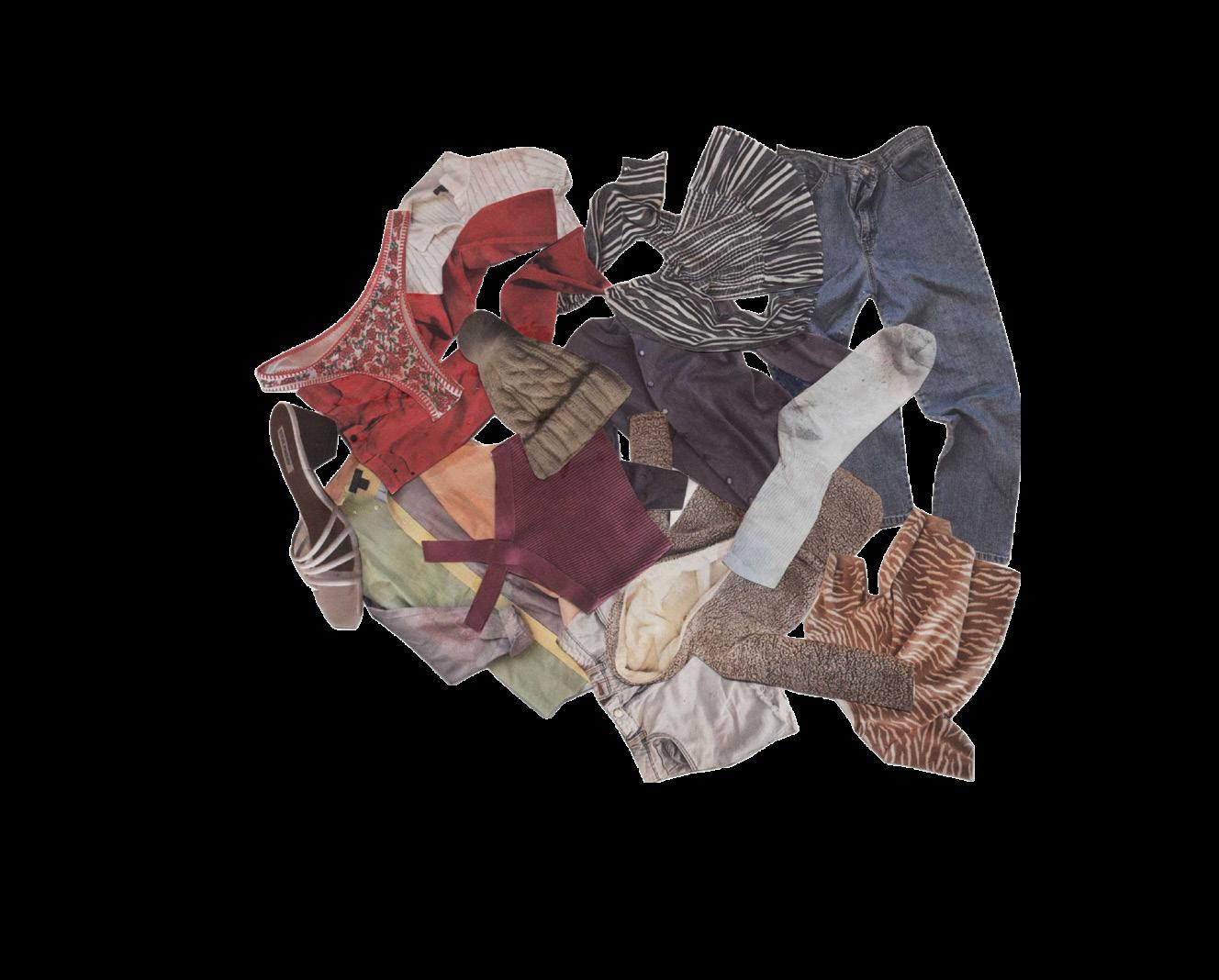
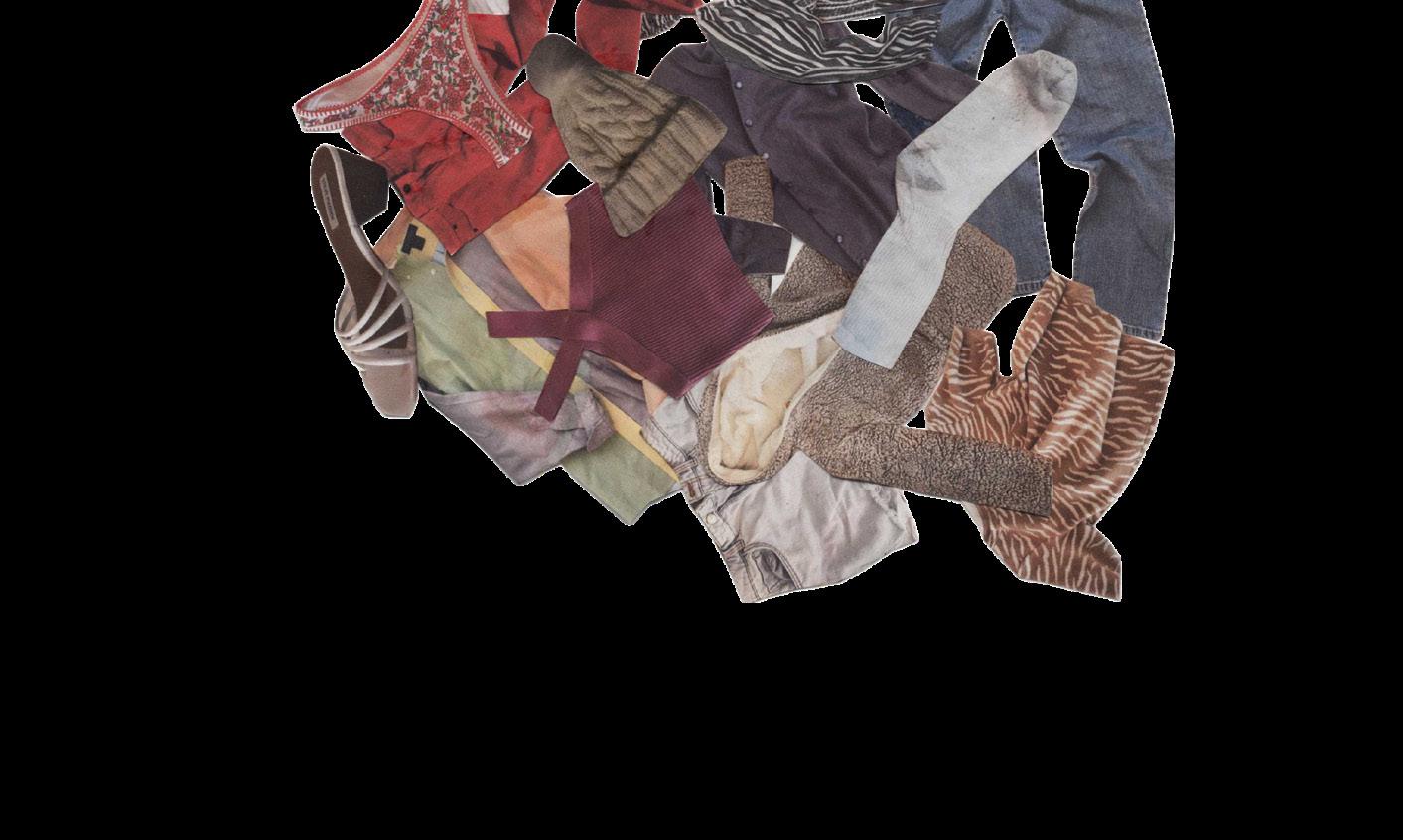

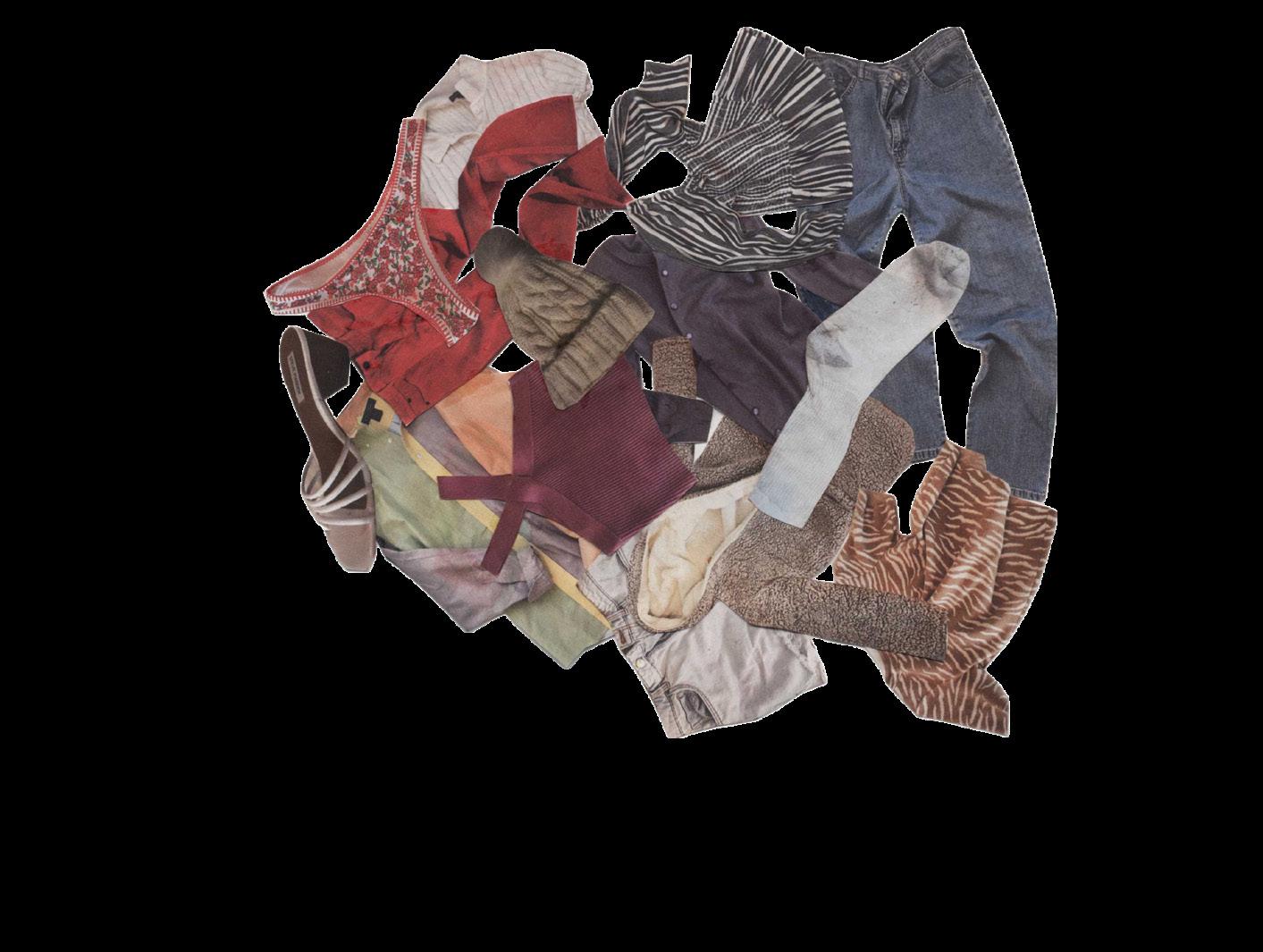
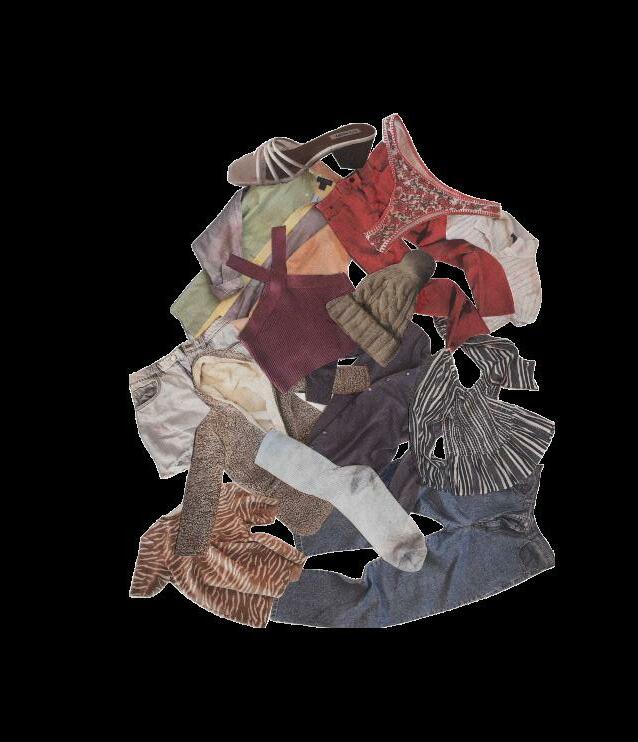
The Center found these enterprises engaged in “intermediary manufacturing,” a process which hides the true source of a product’s place of origin.
Wong has visited similar manufacturers she referred to as “middlemen” that commission factories in Bangladesh and
Consumers can demand better from companies, though. After the collapse of five garment factories that killed over a thousand Bangladeshi workers in 2013, the public put pressure on the Bangladeshi government and retailers to strengthen factory regulation.
In response, global retailers and the Bangladeshi government created the Accord on Fire and Building Safety in Bangladesh. Coxhead said the Accord was the result of the world’s horrified, activism-oriented response.
“After Rana Plaza, intense consumer pressures led U.S. and EU firms sourcing readymade garments (RMG) from Bangladesh to do business only with firms meeting certain standards of employment and working conditions,” Coxhead said.


Coxhead said the new standards were not perfect, but nevertheless, he feels they represented a major step forward from pre-Rana
The Bangladesh Accord expired Aug. 25, 2021, prompting unions and retailers to introduce an updated International Accord. The new accord enables potential expansion to other countries. Despite calls from activists and workers, some fashion companies are refusing to sign it.
But even companies that do sign the Accord have supply chains that are vulnerable to laundered cotton. One of these brands is a Japanese clothing retailer and manufacturer, Uniqlo.
Equivocality of global brands
Uniqlo sustainability department’s global director, Jean-Emmanuel Shein, responded to the allegations that Uniqlo was among the brands identified by the Center’s case studies in an email statement to The Badger Herald.
“We want only long-term relationships with our manufacturing partners — we see this as a marriage and not a date,” Shein said. “As such, we work closely with a few, carefully selected partners, allowing us to work together in continuously improving product quality and communicate regularly to ensure ethical working environments.”
The company has also been involved in a years-long legal battle over workers’ rights, a
in another report from the Australian Strategic Policy Institute linking Uniqlo to two factories associated with Xinjiang cotton.
But Fast Retailing Co. also released a statement of support for the new International Accord, agreeing to adhere to its guidelines.
Shein said Uniqlo has a code of conduct and a third-party verified audit program approved by the Fair Labor Association. He said Uniqlo and its parent company demand that no cotton in their clothes come from forced labor. The company is also working toward having a higher level of traceability of the raw materials in its supply chain, Shein said.
Tangible alternatives to fast fashion

Sorting through a rack of clothing labeled “Classics” in her State Street store, local business owner Jacqueline Iribarren said buying secondhand high fashion will never go out of style.
The sentiment seems to be catching on, with Wong noting it makes her hopeful to see vintage and thrifted pieces becoming increasingly popular among UW students.
Iribarren, who owns and manages the store Rethreads, is excited about that too.
For almost a decade, the local entrepreneur’s store Rethreads has operated out of its State Street location. Iribarren said sustainability has always been a way of life for her since growing up in Latin America. It was there that she was surrounded by a culture of consciousness, one she said she sees reflected in Madison.
Iribarren said Rethreads began as a thrift store where people could buy, sell and trade clothing — until five years ago, when she raised the standards of the clothes she buys for the store.
Now a chic boutique, Rethreads specializes in quality care and attention to detail.
A big part of this rebranding resulted from a boost in high fashion sales to the store from workers at a nearby — now shut down — store called ShopBop. This was a turning point for Rethreads’ trajectory.
Since then, Iribarren has focused on buying and selling second-hand high fashion items in the best possible conditions.
The store offers deals to students, Iribarren said. She keeps up with sorority and fraternity events at UW so she can provide dresses and suits to students looking for quality, fashionable pieces.
Iribarren credits her localized, community-
based approach to the business’s success in a town that’s constantly rotating young people in
To Iribarren, it’s imperative Rethreads is rooted in sustainable practices. For her, slow fashion is a mission. Iribarren said she keeps trends in mind when making purchases for the store, but they don’t dictate what she decides to
Rewearing, sharing and being cautious when purchasing clothing can all help one lower their carbon footprint. The more people who get into these habits, the likelier brands are to respond to environmental and ethical concerns.
It’s been just over a year since Sanchez launched Re-Wear It as a community engagement project to satisfy a requirement in her sustainability certificate. She said she was inspired by similar student-led organizations on other campuses and felt UW had the right audience.
Twice a month, students gather at clothing swaps where they can choose to bring clothes or simply browse, Sanchez said. At a Re-Wear It meeting in March 2022, the organization teamed up with local non-profit The Sewing Machine Project to teach its members how to mend clothing.
Currently, Sanchez is working on a proposal to claim a permanent space on campus for ReWear It through UW’s Green Fund.
Sanchez isn’t the only UW student taking on a role as a group leader for sustainability — Corina Robinson is the director of the JVN Project, a nonprofit organization founded by First Wave scholars that uses the elements of hip-hop to build a curriculum educating young people in the Madison area.
This past year, JVN put on a sustainable, hiphop-themed fashion show.
“Hip-hop is a culture that relies on building off of itself to create new things, and sustainable fashion is kind of that same idea,” Robinson said.
According to Robinson, designers used some recycled fabrics from clothes they already had, thrifted items or clothing from Re-Wear It Wisconsin.
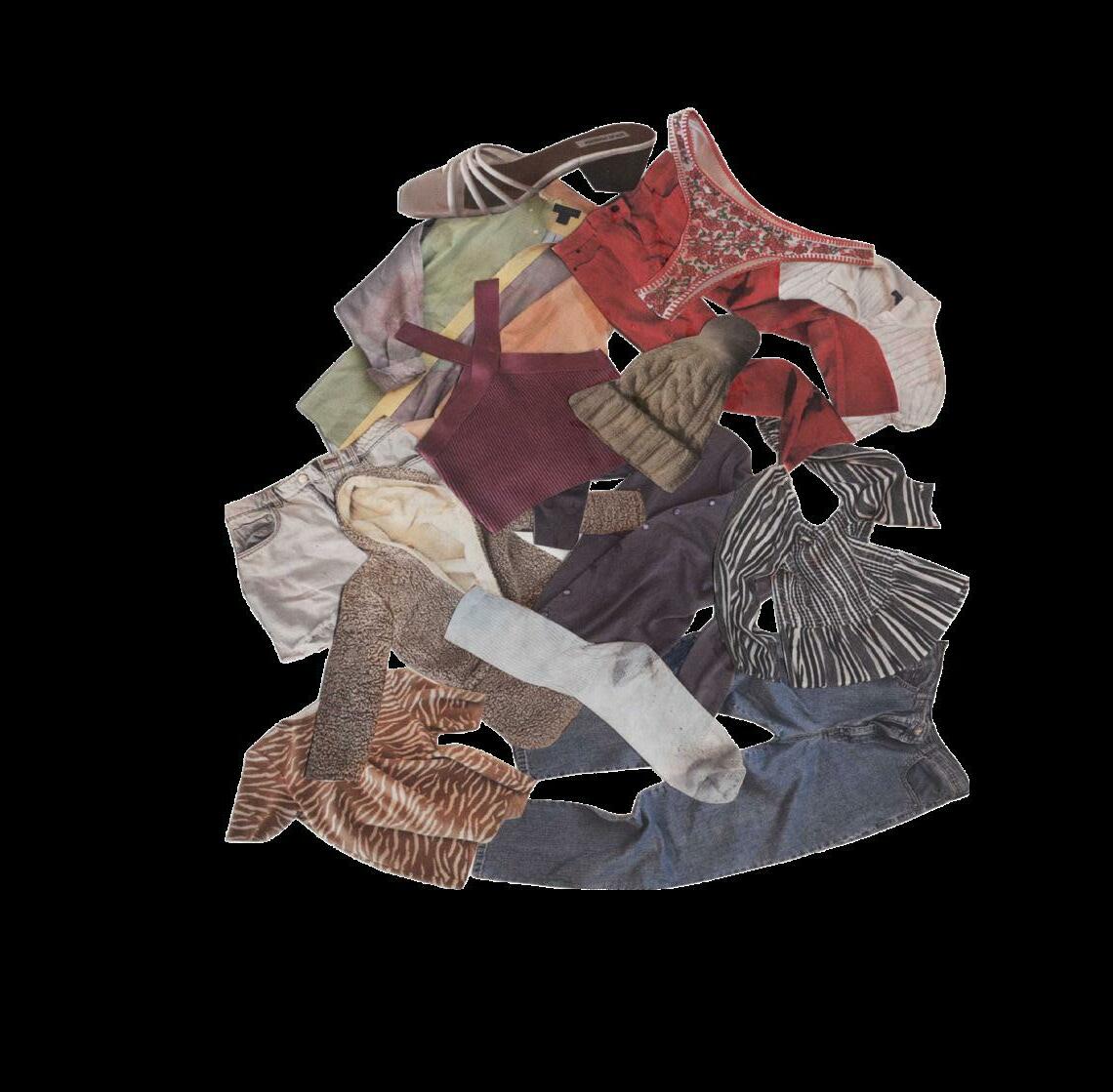




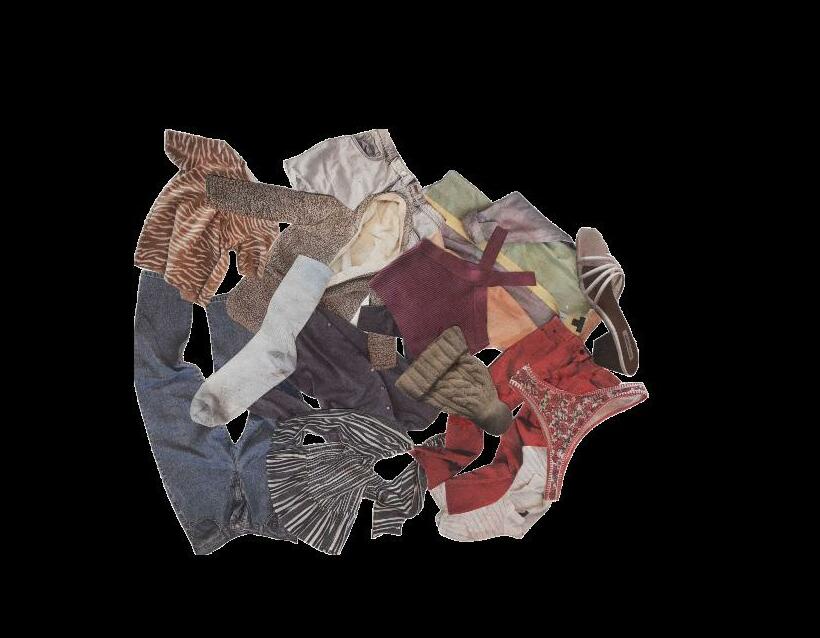

Nzinga Acosta is one of the student designers who participated. For her designs, Acosta used both second-hand and self-made clothing.
“A lot of my wardrobe is thrifted. It has been for a really long time,” Acosta said. “I personally enjoy finding pieces that are unique that I probably wouldn’t find anywhere else.”
As an aspiring designer, Acosta said she feels sustainability is incredibly important.
Acosta said knowing how much the fashion industry contributes to pollution makes her feel awful. But, as a consumer behavior and marketplace studies major, she knows there’s a possibility to change that.
“The consumer has a lot more power than they think,” Acosta said.
Unearthing fashion’s history, labor practices to design a better future
12 badgerherald.com • September 13, 2022
FEATURES
September 13, 2022 badgerherald.com • 13 FEATURES Design by CAITLIN THIES & CHARLOTTE BELLAMY
Biden’s loan forgiveness plan raises question of equal distribution of aid
Recent
by Fiona Hatch Opinion Editor
President Joe Biden recently released his student loan forgiveness plan aimed to help current and former students in higher education. The plan attracted political controversy, but its social impacts cannot be overlooked.
The student loan forgiveness plan will forgive $10,000 of debt for individuals who earn less than $125,000 and families who earn under $250,000 annually. Students who have received a Federal Pell Grant — which demonstrates particular financial aid need — will be eligible for loan forgiveness up to $20,000.
Economists have already begun to debate the costs and benefits of Biden’s plan on the market and national economy. Republicans also voiced their outrage over the proposal.
“Biden’s reckless, unilateral student loan giveaway is unfair to the 87 percent of Americans without student loan debt and those who played by the rules,” GOP Rep. Vern Buchanan said.
Setting aside the economic and political impacts of Biden’s proposal, it is important to examine the social impacts of student loan forgiveness. More specifically, what groups will benefit the most — and are they the ones who actually need help?

First, it is crucial to examine student loan forgiveness under the context of our current situation. The United States has always been one of the poorest developed countries in terms of socioeconomic mobility. Put simply, social mobility refers to the relative ease with which an individual can move between class or economic status throughout their life.
According to an article in The Guardian, a child in the U.S. inherits approximately 50% of their parent’s income position. By contrast, this percentage is closer to 20% in countries like Norway and Canada.
On the other side of the spectrum, only 8% of people in the U.S. who were raised in the bottom 20% were able to climb to the top 20% in their lives. This percentage is nearly doubled in Denmark, with 15% of children achieving this upward mobility.
Not only is mobility in the U.S. extremely limited on both sides of the spectrum, but certain regions and social groups are affected by this phenomenon more than others.
The PNAS Journal found that low-income children raised in the South faced particularly extreme constraints on upward mobility throughout the 1900s. Those who were born under the 25th percentile often failing to exceed the 40th percentile over the course of their lives. The South has historically seen the highest concentration of Black residents compared to the rest of the U.S.
Higher education and student debt are two of the biggest factors that determine the range
plan
discussion about inequities for minorities in the college financial aid system
of mobility one will experience throughout their life. The Pew Research Center found that graduating from college with a four-year degree can drastically improve upward mobility in both class and economic status. The more selective the college, the higher chance a person has of exceeding their current socioeconomic status.
school students expecting to attend college has decreased by almost 20%. Nearly 98% of families and individuals said some form of financial aid would be necessary to make college attendance possible.
Due to the additional barriers to employment and historically lower-paying job opportunities
Our current situation is unsustainable, discriminatory and in dire need of change. It is from this context that we must now examine President Biden’s student loan forgiveness plan.
First, there has been debate over what groups will benefit the most under the Biden administration’s proposal. Some believe Biden’s promise to forgive a portion of individual student loans will affect people of color’s debt balance more than those of white people.
Approximately 71% of Black students take out a student loan over the course of their college career, compared to 56% of white students. Black graduates also owe more on average than white graduates, by about $25,000.
This being said, others argue the plan’s benefits will not be felt by those who need it the most. A study done by the Penn Wharton Budget Model found that between 69-73% of the debt forgiven will have been accrued by those within the top 60% of the income distribution, despite the plan’s cap on wage earnings.
Why might this be the case? On average, Black students make up a significantly lower percentage of college classes than white students. In a study conducted in the fall of 2019, Black students made up only 12.7% of the undergraduate population and they were not equally represented across different types of universities.
For example, only 15% of Black students attended a highly selective university and only 8% attended an elite research institution. According to the University of Wisconsin System, only 2.3% of UW students enrolled in the fall 2021 semester were Black.
Thus, Black students and other students of color have consistently faced lower college participation rates than white students, as well as higher dropout rates. Financial pressures are one of the primary reasons for this education gap.
It is clear student debt is a big problem in our country and Biden’s student loan forgiveness program is most certainly a step in the right direction. But, there are still too many students — particularly Black students and students of color — who are choosing not to attend university because of the financial burden they might face. This is why baseline tuition rates and attendance fees must be lowered in the U.S. and why more resources directly aimed at helping students of color get to four-year colleges are crucial.
The issue with our country’s current college system lies in the cost of attendance. The U.S. has some of the largest price tags for college tuition and fees in the world. This has led to many families and students reconsidering their options, especially in recent years.
A recent survey found the number of high
Black individuals face, higher education is far less achievable. Thus, our country is facing a self-perpetuating cycle in which poverty begets poverty, higher education becomes increasingly unattainable for the lower classes and people of color continue to see less opportunity than white people.
More must be done for students of color. Debt forgiveness is not enough to close the education gap we are seeing across the country, nor is it enough to increase social mobility for people of color.
If student loan forgiveness is to help individuals of all races and ethnicities equally, there must first be equality in our school system at large.
Fiona Hatch is an undergraduate studying political science and international studies.
14 • badgerherald.com • September 13, 2022 OPINION @badgerherald
student loan forgiveness
sparks necessary national
The student loan forgiveness plan creates questions about whether aid is distributed equally. AINA MOHD NASER. THE BADGER HERALD.
Point-counterpoint: Addressing sustainability at UW
Point: UW must take action as soon as possible
by Emily Otten Opinion Associate Editor

UW falls behind many universities in the U.S. when it comes to protecting the planet. The Sustainability Tracking Assessment and Rating System analyzes the sustainability of universities across the categories of academics, engagement, operations, planning and administration. In 2019, UW fell in the bottom three for every single category.
Sustainability in the environmental sense means to protect and preserve the Earth — this includes defending its natural resources as well as slowing climate change. The Intergovernmental Panel on Climate Change announced carbon emissions worldwide should be cut in half by 2030 and zero emissions reached in 2050 to avoid only some of the worst effects of climate change.
This is an incredibly difficult goal to reach, which is why UW needs to take action on climate change as soon as possible. Some would argue a gradual transition to sustainable practices is more desirable so as to not create disorder within the university, but this could not be more treacherous.
Climate change and the destruction of the Earth’s natural resources are not a waiting game — each minute that passes, the condition of the climate deteriorates more and more. Acting quickly is of the utmost importance, and it is also the responsibility of UW to lead these quick actions.
Because the world needs efficient action, UW utilizing the help of student organizations when making decisions regarding sustainability is crucial. Groups, such as the Sustainability Advisory Committee and other student
organizations, are not as hindered by the administrative blocks faced by the university. These groups are able to draft recommendations for the university without jumping through as many hoops.
These organizations also tend to have more passion than the university for increasing sustainability. Programs like the Green Fund are creating headway with their own projects as they have both the freedom and funding to do so. Collaborations between these student organizations and the university through entities like the Office of Sustainability is crucial and necessary to increase sustainability efforts on campus.
Donations from alumni who work within the fossil fuel industry are important to the funding of the university, but promoting sustainability is vastly more important than the relationship between donors as it guarantees a future for new generations. The university must tolerate political and financial losses because the loss of natural resources and destruction of the planet is much more dire.
As the largest university in Wisconsin, a state rife with natural resources and life, UW must make radical changes to improve sustainability across campus. Climate change will not wait for the university to meticulously organize its efforts, which is why collaboration with student organizations can help UW become more sustainable, faster.
Emily Otten (elotten@wisc.edu) is a sophomore majoring in international relations and journalism.
Counterpoint: Students should be encouraged to make change
by Jessica Lewin Opinion Associate Editor
Every two years, the University of Wisconsin files a STARS (Sustainability Tracking Assessment and Rating System) report, with a score from zero to 100, which evaluates UW’s sustainability strategy. UW earned itself a “silver” rating with a score of 59.88. But according to The Cap Times, in comparison to 19 peer institutions, UW scored last. According to The Cap Times, UW scored below average in about 60% of sustainability metrics and bottom three in the academics, engagement, operations and administrative categories.
The report and analysis has raised concerns about the effectiveness of UW’s course of action to combat climate change and enhance sustainability, whether that course of action is even enough and whether more radical change is necessary to further those efforts.
A full transition to sustainability ought to be integrated gradually and radical changes should be researched and planned extensively in order to not disrupt operations at UW. Sustainability changes that do not rely on sudden eradications or damages to the economy are the best way to implement longlasting solutions.
Just like with anything, the changes that stick are the most consistent, practical and gradual ones. Radical changes can completely disrupt everyday life and can be easier to break.
A great first step in the direction of sustainability is to encourage environmentally
responsible choices among students. In many ways, students can direct ways of life on a college campus. So, if students are generally more inclined to live more sustainably, then it becomes easier and less radical for the university to implement sustainable strategies.
Universities can encourage students to participate in simple solutions — buying locally, renting bikes, using reusable items and only using electricity in housing when needed. They can even encourage professors to post textbooks and readings online, to prevent overconsumption of paper.
It’s a lot easier to encourage students to take small mindful steps towards sustainability rather than shake their world overnight, enforcing particular mandates on consumptions.
From there, universities may be able to implement green housing, making the dorms on campus more environmentally responsible and implementing better practices.
What will help the most in fostering sustainability on campus will be encouraging and teaching more sustainable practices to students in order to change the culture of overconsumption and environmentally irresponsible behavior. The more students willingly change their attitudes and become more individually mindful, the less the UW administration will have to come in and enforce radical, short-lived changes.
Jessica Lewin (jrlewin2@wisc.edu) is a junior studying journalism and philosophy.
While change is undoubtedly necessary, disagreement persists over nature of transition to sustainability
The University of Wisconsin has fallen behind its peers in efforts of fossil fuel divestment, sustainability coursework and integrated sustainability efforts across campus. While some argue radical change is necessary to address the immediacy of climate change, others believe gradual implementation of sustainable practices will lead to more long-lasting solutions.
What is the best approach to solve this issue?
CAROLINE CROWLEY. THE BADGER HERALD.
September 13, 2022 • badgerherald.com • 15 OPINIONfacebook.com/badgerherald
Class action lawsuit highlights inequities for criminal defendants
by Celia Hiorns Opinion Editor
Eight named plaintiffs filed a class action lawsuit against Gov. Tony Evers and Wisconsin’s Public Defender Board Aug. 23 over a lack of legal representation for lowincome defendants in criminal cases. The plaintiffs have been waiting in custody for extended periods of time because they cannot afford private attorneys but have yet to be assigned a public defender.
Four litigation groups, including the Wisconsin Association of Criminal Defense Lawyers, filed the suit, asking the state to immediately appoint legal counsel to those in need or dismiss the criminal charges against them.
The lawsuit cites the statewide backlog of 35,000 criminal cases as a reason for prompt action. With such a large number of pending cases, defendants who should be presumed innocent under Fifth Amendment due process protections could spend months or longer in custody. Delays in criminal trials are often the result of public defender shortages. The issue stems from multiple causes, all of which are complicating factors in the right to receive legal representation.

Adam Plotkin is the legislative liaison at the Wisconsin State Public Defender’s Office. He said the shortage comes down to two main factors — workload and compensation. Plotkin said pay is very low compared to the amount of work publicly appointed attorneys are expected to complete. Over the past five to 10 years, this imbalance has increased as the practice of law has changed and technologies such as video evidence have emerged.
With four out of five criminal defendants unable to afford counsel, the manageable workloads of private attorneys are a luxury for the backlogged public defender system.
The issue of insufficient pay has been partially addressed in the past. In March 2021, Gov. Evers signed a bill that allows for meritbased pay increases for public defenders in the state. Intended to incentivize experienced attorneys to stay in the public sector, the bipartisan measure was a hopeful effort to resolve the shortage. Yet sttorneys continue to lean toward the private sector for other benefits, such as health insurance and childcare plans.
The COVID-19 pandemic has only exacerbated the crisis. Shutdowns delayed court processes, which overloaded many employees to the point of resignation. The public defender system cannot keep up with the demands amid nationwide labor shortages. Evidently, this backlog creates challenges in granting due process to criminal defendants who can’t afford a private attorney.
But like other aspects of the criminal justice system, these conditions do not impact all Wisconsinites equally.
“There are significant racial disparities in the criminal and legal system and so we see that reflected in our clientele,” Plotkin said. “A disproportionate number of people of color who are charged with crimes qualify for a public defender.”
Compounded instances of inequity in the justice system make the impacts even more pervasive for low-income defendants. Plotkin cited cash bail as another example of how socioeconomic status plays a role in one’s experience as a criminal defendant.
Though, on paper, bail gives criminally charged defendants an opportunity to be
protects public safety,” Plotkin said. “But under the cash bail system, if I’m charged with the same crime as you are, but you have [financial] means and I don’t … what makes you less risky than me?” A similar principle holds true in the public defense sector. Criminal defendants who have the means to hire private counsel immediately undergo a much more prompt definition of Sixth Amendment speedy trial rights.
Ultimately, while policies may not explicitly enforce discrimination, prejudice against lowincome people persists, which fundamentally influences their experiences as they move through the criminal justice system.
The inequity of public defense brings to light a larger flaw of law enforcement — the
according to WACDL attorney Hank Schultz. Instead, the plaintiffs in the suit want to place the responsibility on the government to balance the criminal charges they issue with their ability to resolve them. In fact, the lawsuit on its own represents a technical solution to a structural problem. WACDL attorney John Birdsall emphasized the responsibility of the government to solve the crisis.
“This lawsuit hopefully is a wake-up call to build a system that actually operates and actually functions fairly for everybody involved,” Birdsall said in an interview with Wisconsin Public Radio.
Should the plaintiffs win the class action lawsuit, the state must consider its course of action. They would need to derive the resources to appoint legal counsel in the future or handle the consequences of dropping criminal charges — potentially leaving the victims of crimes without justice.
Sufficient appointment of counsel would require coordinated initiatives on the parts of the Wisconsin State Public Defenders and other government entities. Many of the current efforts led by the Public Defender’s Office work to bolster support around the attorneys in the midst of the shortage. This comes in the form of paralegal and temporary staff assistance to reduce the workload placed on public defenders.
The Wisconsin State Public Defender’s Office will submit its budget request for the next biennium Sept. 15. Plotkin said this will be a considerable request intended to address recruitment and retention issues, increase pay, hire support staff and otherwise mitigate the crisis.
“[These measures] are all geared toward that singular effort of making sure we have enough resources to appoint counsel to every person who qualifies,” Plotkin said.
Clearly, the State Public Defender’s Office is acutely aware of the issue and uses the resources it has to implement meaningful change. But ultimately, being granted the support they need to resolve the public defender crisis requires integrated efforts across many government sectors. Understanding the backlog as an impact of income-based prejudice is critical for addressing the issue at its root.
released from detention, many people without the financial means to post bail have no choice but to remain in custody. This is a major flaw in the system, as the presumption of innocence is not applied equally across all socioeconomic backgrounds.
“A big fallacy of cash bail is it somehow
justice system lacks the capacity to address the issues it creates. In other words, the state is handing out criminal charges faster than it can resolve them and low-income defendants are suffering as a result.
The class action lawsuit is not intended to figure out how to repair this broken system,
Of course, more basic resources are required to support an essential — though grossly overworked — group of public servants. Entirely solving the public defender crisis, however, demands a nationwide reckoning of the socioeconomic disparities inherent in a deeply flawed justice system.
Celia Hiorns (chiorns@badgerherald.com) is a sophomore studying journalism and political science.
Wisconsin Association of Criminal Defense Lawyers sues state over public defender shortage, extended custody for low-income defendants
OPINION @badgerherald
The class action lawsuit challenges the government to offer better resources for public defenders.
EDWARD KUSTNER. THE BADGER HERALD.
16 • badgerherald.com • September 13, 2022
The war at home: Supporting Ukraine is vital for preserving global peace
by Josh Standal Opinion Columnist
Feb. 24, 2022, Russia launched missiles at several cities in Ukraine and hundreds of thousands of Russian soldiers invaded shortly after. The Western world was quick to rush to the aid of Ukraine, sending over weapons, supplies and vehicles to help the Ukrainian people.
The war between Russia and Ukraine was originally expected to be short, with Russia easily marching to the capitol of Kyiv and taking control of the country.
But with the remarkable resilience of the Ukrainian people and help from dozens of foreign countries, the war has reached the sixmonth mark, with Russia still far from victory over Ukraine.
Despite the fact this war is raging thousands of miles away from the U.S. and Wisconsin, citizens are still feeling the effects. Since the beginning of the war, the U.S. has felt two main consequences of the Russian invasion — economic strain and political conflict.

Russian supplies account for 8% of imported oil in the U.S. After President Biden placed a ban on the purchase of Russian oil, gas prices immediately began to rise. March 2022, the national average for gas hit $4 per gallon for the first time since July 2008.
In addition to increasing gas prices, the cost of many other basic necessities is rising as a result of bans on Russian products and imports.
The combined landmass of Russia and Ukraine is considered one of the world’s seven major “breadbaskets.” This area produces massive amounts of wheat, corn and fertilizer and as long as the war rages, minimal amounts of these products will be produced and sold to other countries.
As the supply of such products has dropped significantly, inflation has skyrocketed all across the U.S. — and Wisconsinites aren’t exempt from these changes. In Wisconsin, the price of groceries has risen between 15%-18%, utility costs have risen between 17%-36% and the cost of vehicles has risen by 15% over the past year.
Since the war’s onset, the U.S. has continued
to supply aid to the Ukrainian people. Aug. 24, President Joe Biden announced the U.S. government would send another $3 billion in arms and equipment to Ukraine and its forces.
Though supplying aid to Ukraine has been strenuous for the U.S. and its citizens, it is vital that the U.S. continues to show its support abroad. By adopting an isolationist policy, the U.S. would set a dangerous precedent, showing President Vladimir Putin that it will not interfere with his imperialistic tendencies in Eastern Europe.
But inflation and economic changes are not the only side effects of the war felt in the U.S. While the rise of inflation has made essential items such as bread and gas more expensive, Democrats and Republicans are actively debating what role the U.S. should play in the war, if any.
President Biden and the vast majority of members of Congress across party lines have continued to advocate for any possible aid for Ukraine, but some of the more radical Republicans have become less enthusiastic about supporting the massive aid packages being sent to Ukraine.
Many Republicans who still associate with former President Donald Trump are pushing for a more isolationist outlook regarding Ukraine. They argue that massive aid packages being sent to Ukraine should instead be used to address domestic issues, such as the floundering economy.
The varying political perspectives about how to address the war in Ukraine affect everything from local politics to the 2024 presidential race. With the 2022 midterms approaching quickly in November, the topic of how to support Ukraine will likely be an important issue for many voters and could have a significant influence on the polls.
Though it is clear the war in Ukraine is putting a strain on the American economy and political sphere, one thing is clear — the U.S. must continue to support the Ukrainian fight for freedom. The temporary inconveniences Americans face are insignificant compared to the broader struggle for democracy Ukrainians face as their country is under siege. Further, by halting aid to Ukraine, the U.S. would be setting the precedent that it would not interfere with Russia’s imperialist tendencies, which could ultimately lead to Russia attempting to take over other countries along its borders.
Russia is actively attempting to strip Ukrainians of their rights and institute a proRussian leader. As long as the U.S. champions itself as the protector of freedom and justice, we must fight to protect countries like Ukraine. For if Russia is successful, the world must prepare for a Cold War-caliber struggle for democracy.
Josh Standal (jpstandal@wisc.edu) is a junior majoring in history.
Despite local impacts on inflation, elections, continued support for Ukraine is necessary to uphold values of democracy nationally and abroad
Wisconsinites deal with rising prices and varying political perspectives as a result of the war in Ukraine.
MAGGIE
HERALD.
September 13, 2022 • badgerherald.com • 17
OPINIONfacebook.com/badgerherald
DEGNAN. THE BADGER
Wisconsin Union Theater releases star-studded fall schedule
variety of
by Nick Woodhouse Arts Etc. Editor
The Wisconsin Union Theater is set to resume its annual concert series this September, a program that attracts many celebrated jazz, folk and classical musicians to the performing arts halls of Madison each year.
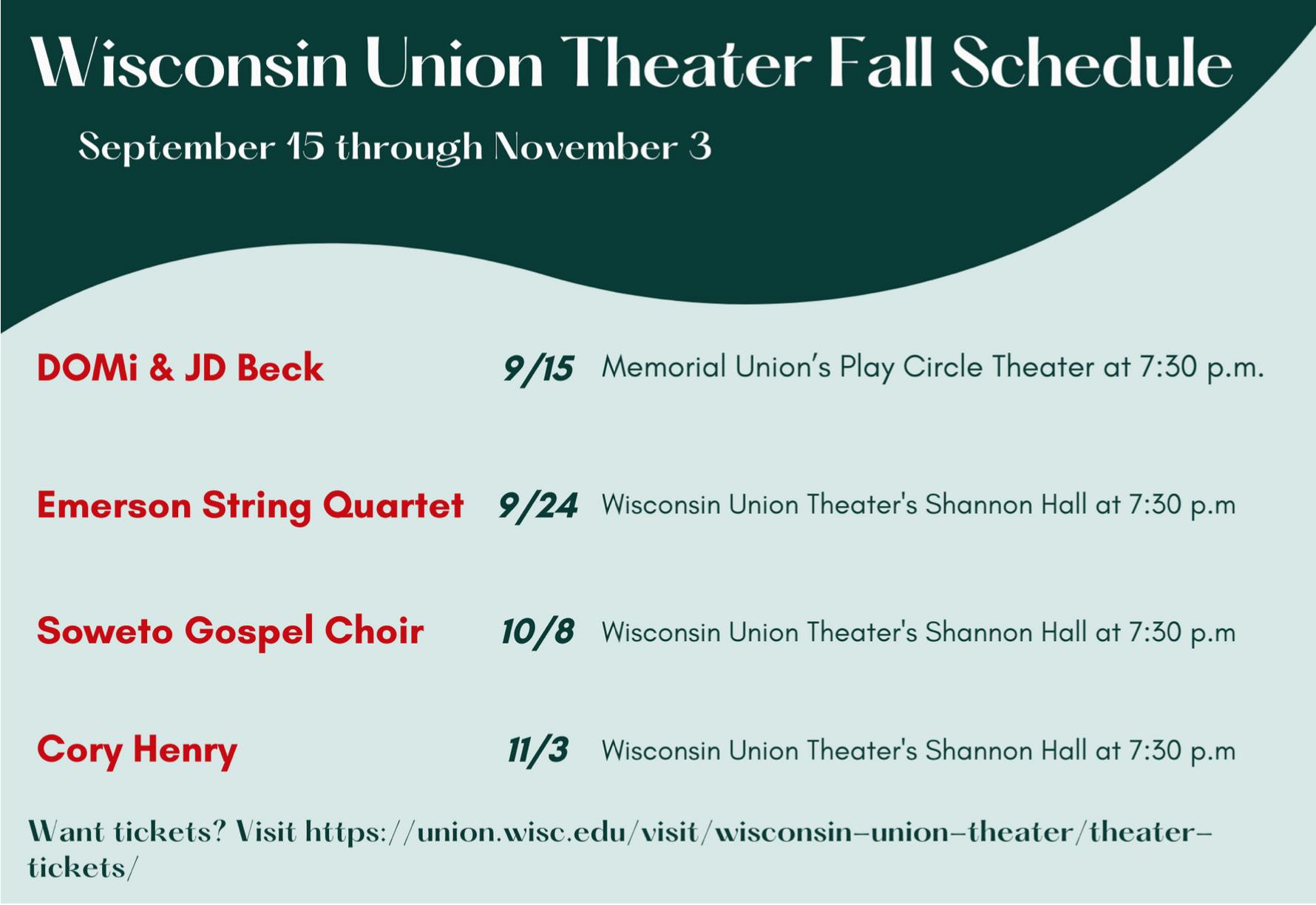
Highlights of last season’s lineup included soloists like world-class violinist Gil Shaham, legendary jazz composer Terence Blanchard and highly acclaimed groups such as Sphinx Virtuosi Chamber Orchestra and Grammy-Award Winning Third Coast Percussion. The Wisconsin Union — in partnership with the Wisconsin Union Directorate (WUD) and Performing Arts Committee (PAC) — has released yet another star-studded lineup for the 2022-2023 concert series.
Here is just a preview of the many performers set to showcase their skills in Madison this Fall:
Sept. 15: DOMi & JD Beck
Viral youth group sensation DOMi & JD Beck will kick-off the WUT’s Jazz Series. By pairing blends of music ranging from 1970s classics to popular 2000s Pokemon riffs, the duo has taken the Jazz world ablaze with their youthful energy and creative musical concoctions. Recent works by DOMi & JD featured popular artists like Snoop Dogg, Busta Rhymes and Anderson .Paak. The performance will take place in Memorial Union’s Play Circle Theater at 7:30 p.m.
Sept. 24: Emerson String Quartet
Raising the curtains on the 2022-2023 Classical Music Series will be the Emerson String Quartet. The group was formed in the 1970s by students at the Julliard School of performing arts in New York City. Since then, the quartet has produced over thirty albums, for which they have won nine Grammy Awards. In 2004, the group was named the recipient of the Avery Fisher Prize, an award given annually to American Musicians for outstanding achievements in classical music. In 2021, the group announced that they will be disbanding
to focus on teaching and individual endeavors after the 2022-2023 season, meaning the quartet will perform in Madison for the final time this September. The performance will take place in Wisconsin Union Theater’s Shannon Hall at 7:30 p.m.
Oct. 8: Soweto Gospel Choir
One of the last additions to an already starstudded fall schedule was the Soweto Gospel Choir which will visit Madison in early October. The group, formed in 2002, consists of over fifty members representing different churches and ministries across South Africa. The group quickly rose to fame in 2003 when its song “Voices of Heaven” reached the No. 1 spot on Billboard’s World Music Chart. In 2009, the choir won their first Grammy for their second CD entitled “Blessed.” Since, the Soweto Gospel Choir has continued to produce music independently and
in collaboration with top artists in Africa and worldwide. The group is also well known for their devotion to charity both domestically and abroad—perhaps most notably creating their own foundation which works to find homes for orphaned children affected by the AIDS epidemic. The performance will take place in Wisconsin Union Theater’s Shannon Hall at 7:30 p.m.
Nov. 3: Cory Henry
A major enhancement to the Jazz Series this fall is 30-year-old American musician and record producer Cory Henry. Henry started his solo career in 2020 with his first independent launch entitled Art of Love after spending over a decade and a half as part of the Grammywinning instrumental ensemble Snarky Puppy.
On the road since 2006, Henry has toured alongside mainstream names such as Bruce
Springsteen, P. Diddy and The Roots. Henry has also cooperated numerous times with legendary rapper/producer Kanye West and he was even credited as a composer on West’s latest studio album Donda. Henry, one of the bright young faces of the jazz world, will serve as the third installment of the Wisconsin Union Theater’s Jazz Series in early November. The performance will take place in Wisconsin Union Theater’s Shannon Hall at 7:30 p.m.
This season’s performing arts schedule includes in-person performances along with an online attendance option. Tickets for individual performances can be found on the Wisconsin Union Theater website. Tickets for students are offered at a discounted price. For more information regarding the upcoming shows, be sure to visit the Wisconsin Union Theater Website and follow their social media platforms.
18 • badgerherald.com •.September 13, 2022 ARTS @badgerherald
Fall 2022 lineup features Grammy-Award winning artists,
genres
AUDREY THIBERT. THE BADGER HERALD.
Ranking the top five sporting events of the semester
by Sam Harrigan Sports Editor
It’s another loaded semester of athletics at the University of Wisconsin. With nearly every sport competing at least once this semester, there is sure to be a lot of action on campus.
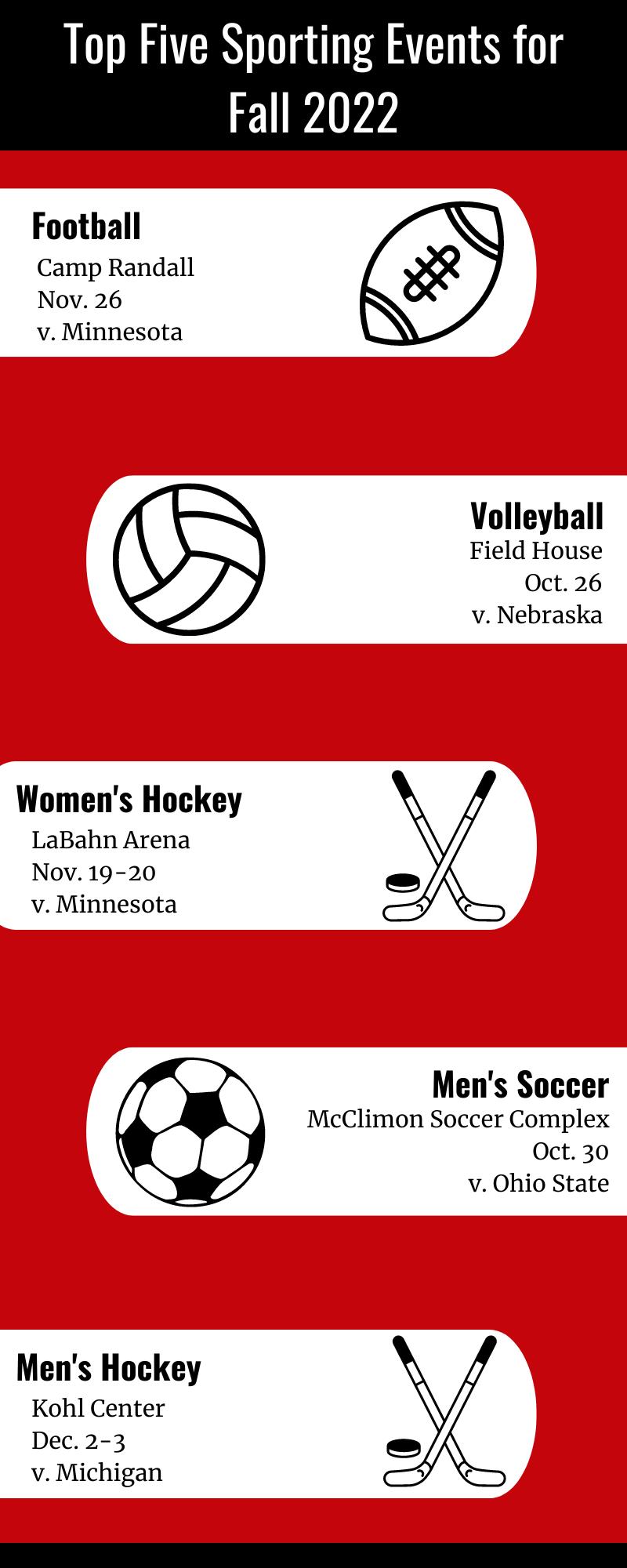
Here are the top five home games of the semester for Wisconsin athletics.
1. Football: Minnesota, Nov. 26
The last game of the regular season will also serve as the 132 meeting between two of the biggest rivals in college football. This year’s edition of the Battle for Paul Bunyan’s Axe figures to have some extra drama. Both Wisconsin and Minnesota are expected to have above-average seasons that should have them competing for a Big Ten Conference Championship.
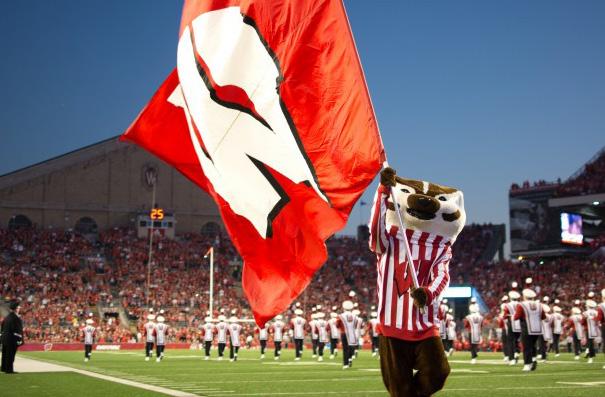
This meeting always stands as one of the sports’ best rivalries, but this year, the projected success of both teams adds a little more significance to an already important game.
It seems more likely than not that this game will be announced as a night kickoff, showcasing its importance for both teams.
This game, played the Saturday after
Thanksgiving, is the biggest game on campus all semester, as it could easily end up in a Rose Bowl appearance for the winner.
2. Volleyball: Nebraska, Oct. 26
A rematch of the 2021 national championship game comes to the Field House on a Wednesday in late October. This game sold out instantly and figures to be arguably the best match of the entire college volleyball season.
Nebraska brings in a lot of returning talent and will certainly have a chip on their shoulder as they look to avenge their loss in last year’s national title game.
Both teams are extremely talented and this has all the makings of a top-five matchup. The Badgers will be tested, but will have the home court advantage of the Field House at their back.
3. Women’s Hockey: Minnesota, Nov. 19-20
Arguably the best rivalry in all of college hockey reignites when the Minnesota Golden Gophers visit LaBahn Arena. The dates of this series mark the 23rd anniversary of the first time these two teams met.
The Border Battle figures to be as competitive and high intensity as ever, as both teams project
as national championship favorites.
This is the lone meeting this season in Madison, and it is imperative that the Badgers win these key games at home.
4. Men’s Soccer: Ohio State, Oct. 30
Ohio State’s visit to Madison will hold a little bit more significance this year as it is the last regular season match for both teams.
Ohio State has the makings of arguably the Big Ten’s best team, and this is a golden opportunity for Wisconsin to secure a big conference win in the last match of the season.
While the Badgers have struggled early on this season, there remains an abundance of talent on head coach Neil Jones’ roster.
Hopefully by the time late November rolls around, Wisconsin will be in contention for an NCAA tournament appearance and give this match the significance that it deserves.
5. Men’s Hockey: Michigan, Dec. 2-3
Another big rivalry returns to the Kohl Center when the Michigan Wolverines visit Madison in the last home series of the semester.
Michigan will have a retooled roster this year, and the loss of head coach Mel Pearson makes things even more interesting up in Ann
Arbor.
Michigan always presents a challenge for Wisconsin — the Badgers were outscored by eight goals in the two meetings between the teams in Madison last year. But this year provides a unique opportunity for Wisconsin to secure some big wins.
Each of these games will provide a fantastic opportunity for Wisconsin as they look to enter winter break strong with two huge conference wins.
There is never a shortage of good games on the Wisconsin campus. But the recent success of so many different teams adds an extra layer of importance to so many of the traditional Big Ten rivalries.
But don’t forget — these are just five of the biggest games. There are plenty more opportunities for other events to take over the spotlight as each team’s season progresses.
Brief glimpse into the biggest Wisconsin home games this fall semester
September 13, 2022 • badgerherald.com • 19
SPORTSfacebook.com/badgerherald CAROLINE CROWLEY. THE BADGER HERALD. There will be many exciting sporting events this semester with UW’s range of successful teams. KATIE COONEY. THE BADGER HERALD.
Volleyball: Shooting stars open room for new talent
by Ian Patton Sports Editor
A City of Champions is a classification bestowed upon the understanding of consistent success and repeat victory on the biggest stage. In that respect, Madison and the Wisconsin women’s volleyball team are at the top of the mountain. The downfall of this lofty standing is that from the top, you have the farthest distance to fall, and this year’s Badgers are without last season’s strongest tethers.

With these all-league talents entering the stratosphere of professional volleyball and sports, Kelly Sheffield’s group has had to re-identify its dynamic. After several season games, the Badgers have begun to show their new core.
New faces have come onto the court to replace previous players like Danna Rettke and Grace Loberg. Coming from both off the bench and other states as well as overseas, new players have begun to hold up the weight of the season. On a team that has sat at the top of the NCAA Women’s Volleyball world, these players have flown relatively under the radar.
With players Coach Sheffield has called unique talents in our game as well as elite European resumes, these players are far from new to the spotlight. Are you, the average reader of a small college newspaper, the first to know about their
ABBY CIMA. THE BADGER HERALD.
talent? The answer is no, but the moment you step into the University of Wisconsin Field House, you will quickly learn their names.
In 2021, the Badgers were a steamroller powered by a diesel engine comprised heavily of senior talent. A front row comprised of Rettke and Loberg highlighted an incredibly talented team.
But coming into this season, the Badgers’ killer front row is gone. Rettke has ascended to the ranks of professional playing for Vero Volley Manza. Additionally, Loberg has continued a presence in the UW Field House working as a commentator for the Big Ten Network. The team seems to be without its gas, but as the season progresses, this
will be proven wrong.
Izzy Ashburn:
Ashburn is far from a newcomer to Badger success as she enters her senior season. Ashburn, a Minnesota native and business analytics student, holds the UW service ace percentage in a career record, averaging 0.41 a set.
This season she has stepped up from off the bench to become an immediate and high-level contributor to Sheffield and Company’s quest for a second consecutive championship. Named a triteam captain, Ashburn has been a powerful piece in the back row, leading the team in assists and service aces with 95 and seven, respectively.
Sarah Franklin:
Where Ashburn participated in the UW Field House ring ceremony, Franklin joined the Badgers after two seasons in East Lansing, where she was named First-Team All-Big Ten. With the loss of the pure unhinged dominance Dana Rettke wielded on the front line, the Badgers needed someone to come in and get kills.
Franklin has made an impact right away, notching 62 kills through four games, a mark that leads the team healthily. Franklin adds even more power to a team with an elite kill percentage.
Gulce Guctekin:
It is not often that a freshman gets much playing time on any team, let alone a defending National Championship team. As a five-year member of the Turkish national team, it is little surprise that Guctekin breaks the mold. Guctekin is tasked with service and defense in her spot as a libero, a role that has garnered her success and validation in Europe for years.
Guctekin’s transition to NCAA play has done nothing but inflate her numbers as she leads the team with 52 digs. While Guctekin is part of a team heavy with juniors and seniors, she shows that the Badgers’ success will remain in the Field House for years to come.
While the Badgers have never had difficulty finding it, winning requires talent. For the average fan, questions may remain as the defending champs look to solidify themselves at the top of the mountain. The answer to these doubts lies in the new core and their powerful early statement.
Whether it is the defensive play of Ashburn and Guctekin or the offensive dominance already displayed by Franklin, these players hit the ground running. The Badgers are still early in the season, and with a hard conference schedule quickly approaching, they need a team effort.
The momentum of last season fired players and teams alike into the highest levels of the volleyball world. As the Badgers continue to rise, the question remains — does their new talent have enough fuel to keep the ship afloat? Only time will tell, but we know stars are beginning to shine through the windows of the UW Field House.
20 • badgerherald.com •.September 13, 2022
What new players have to offer as old players depart
The UW volleyball team is known for its success — but can they keep up their steam from last year?
SPORTS @badgerherald
No. 19 Wisconsin Badgers upset at home by Washington State, 17-14
by Doug Scales Sports Reporter
The University of Wisconsin Badgers football team lost in a painful fashion Saturday afternoon, losing 17-14 to the unranked Washington State Cougars.
It was a game highlighted by mistakes on both offense and defense for the Badgers, who failed to capitalize in multiple crucial situations.
Throughout the entirety of the game, Wisconsin seemed to struggle to adjust to the spread-out, fast-paced style of the Washington State offense. The Cougars featured a plethora of screens and run-pass options with two receivers stacked on each side, something uncommon in the Big Ten conference.
In a post-game interview, Wisconsin linebacker Kamo’i Latu was asked if it was difficult to prepare and adjust to the other team’s style.
“They run a fast, no-huddle offense,” he said. “We just gotta come Monday and see our mistakes.”
With five minutes remaining in the fourth quarter, Wisconsin seemed to be putting together what would have been the game-winning drive. On 2nd-and-11 from the Washington State 35-yard line, Graham Mertz connected with tight end Clay Cundiff on a drag route over the middle. Cundiff was tackled and fumbled the ball, which was recovered by Washington State at their own 11-yard line.
With only one timeout remaining, the Badgers were unable to make a stop and get the ball back. Finally, they forced a fourth down with six seconds remaining, but Washington State quarterback Cameron
Ward rolled out of the pocket and heaved the ball out of bounds as time expired, according to the Wisconsin Athletics website.
Despite the untimely error, Cundiff was one of the lone bright spots on the Wisconsin offense and scored the Badgers only two touchdowns, with receptions of 17 and 10 yards during the second quarter, according to the Wisconsin Athletics website.
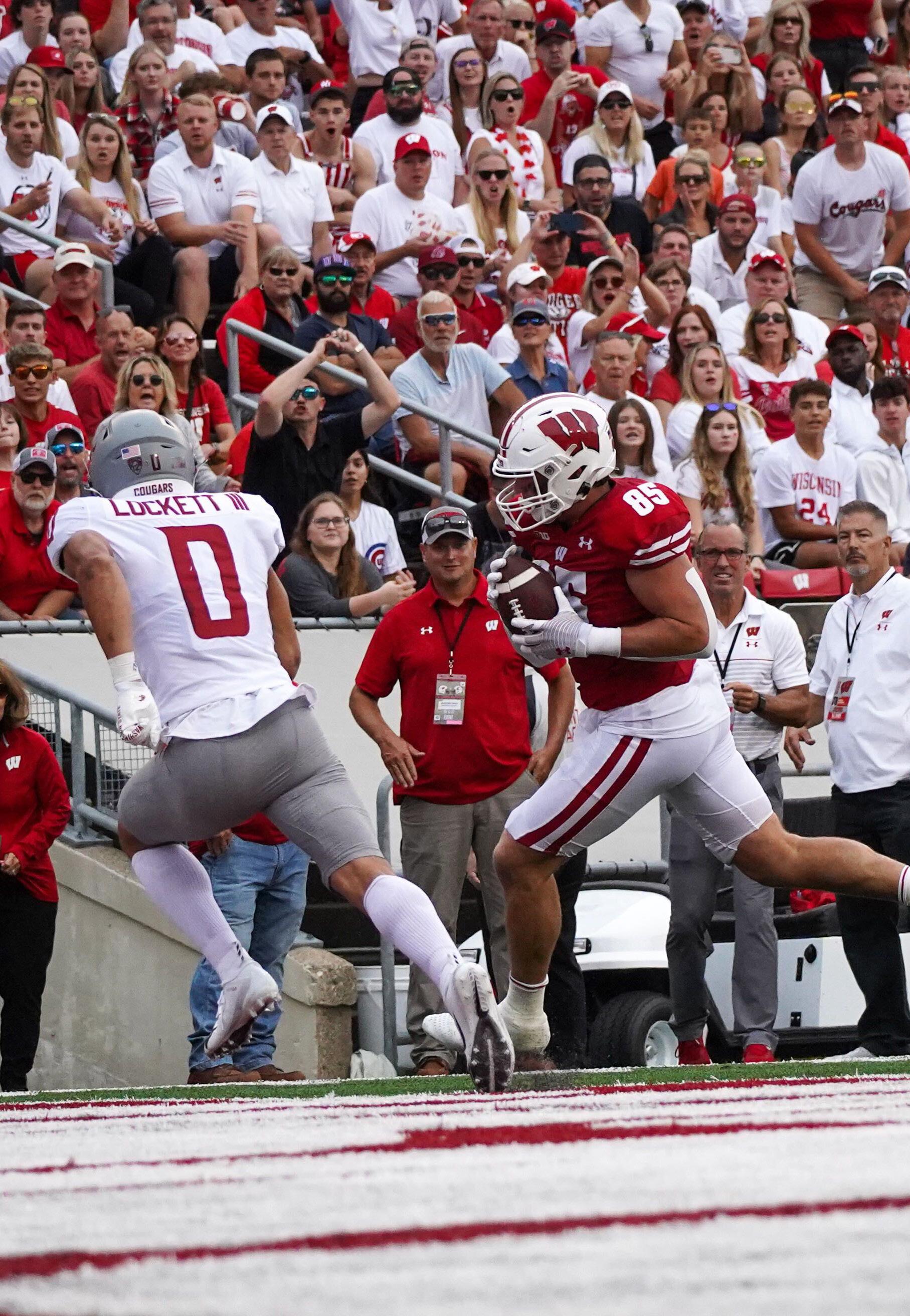
On top of the fumble, the Badgers missed two crucial field goals that would have been the difference in the game. Kicker Vito Calvaruso missed wide right on a 51-yard attempt late in the first quarter, keeping the game scoreless. Calvaruso had another opportunity to tie the game entering the fourth quarter, but came up short on a 43yard attempt.
In a game where the offense struggled mightily to move the ball up the field, it was crucial for the team to capitalize on some of the easier opportunities.
“The object of the game is to score more points and we didn’t do that… we did some things today that make it hard to win,” Wisconsin head coach Paul Chryst said in a post-game interview.
This simple mantra was about all Chryst would offer to the media after Wisconsin’s loss.
Despite the disappointing loss, there were a few players who stood out and played particularly well, including Latu, who had six total tackles and the hardest hit of the game with his second-quarter sack.
Running back Braelon Allen also played well, carrying the ball 21 times for 98 yards. Surprisingly, it’s one of the worst games he has played as a Badger, which is a testament to how solid he has been.
Defensive back Max Lofy came up with his first career interception early in the game, stopping a driving Washington State offense deep in Wisconsin territory.
Graham Mertz has also looked much improved over the first two games of the season, making good decisions and allowing plays to develop. He was 18/31 for 227 yards, two touchdowns and an interception, according to the Wisconsin Athletics website.

Throughout the game, Mertz was challenged in his decision-making, and decided to play it safe. He missed on a few deep balls to Markus Allen, but none leading to mistakes as he found him in oneon-one coverage up the sideline both times.
In the post-game interview, Mertz was
asked about his development and growth as a passer.
“I think the biggest thing was selfreflection,” he said. “Taking a step back and realizing, okay, what are my weaknesses?”
Watching Mertz continue to develop and grow is one positive that can be taken away from this game.
It was a disappointing loss, one that is definitely difficult to swallow this early in the season. The positive takeaway is that the Badgers still have the talent they need to play their brand of football.
With better preparation and execution, this team looks to bounce back next week at home against New Mexico State.
Badgers lose stunner, losing first non-conference regular season game since 2018
Players were disappointed with the unexpected loss.
The Badgers faced a surprising loss during the Sept. 10 game at Camp Randall.
September 13, 2022 • badgerherald.com • 21 SPORTSfacebook.com/badgerherald
JUSTIN MIELKE. THE BADGER HERALD.
JUSTIN MIELKE. THE BADGER HERALD.
Wordle players loot NYT headquarters after Wordle set as ‘GULLY’


‘Shut your damn mouth,’ protester says to NYT chief puzzle maker
by Phoenix Pham Banter Editor
Millions of Wordle players gathered outside the New York Times’ headquarters yesterday to protest what they claim is the Times’ ruining of Wordle. This article is brought to you by Investigative Reporter Phoenix Pham.
“Enough is enough,” Lauren, a fifty-year-old project manager from Wisconsin, roared into her bullhorn. A crowd of millions roared back. They stretched all the way from where Lauren stood in front of the NYT headquarters to Bryant park, four blocks away.
“The Wordle was meant to be fun,” Lauren shouted. “It’s supposed to have common words for answers. Not words like ‘bayou’ and ‘gully.’”
“What the fuck is a gully?” one lady screamed, her face red with fury.
“We were supposed to feel smart when doing the Wordle,” Lauren said, spit flying from her lips. “Not like illiterates!”
A man wearing a trench coat — and only a trench coat — threw a molotov cocktail at the NYT’s door, where it shattered and set the concrete steps ablaze. His hair was greasy and his eyes were as wild as the fire burning before him.
“Anarchy!” he shouted.
Lauren turned when she heard the NYT’s massive front doors open. A short, balding man wearing a monocle and a gray suit came out.
“My fellow men, a moment please, a moment!” he said in a British accent.
Lauren held up a hand and the crowd hushed.
“My name is Harold, the chief puzzle maker at the Times,” he said. “We at the Times are on your side! We admit, we have made a most egregious faux pas, but we have heard you and we vow to do better!”
Harold cleared his throat, smiling nervously and sweating so profusely his monocle slipped down his face.
“As a sign of our utmost and deepest apologies,
we at the Times have agreed to give you the solution to today’s Wordle.” Like the shadow of a plane over the land, a silence fell over the crowd. Only the honking of far-off traffic could be heard.
“The word is …” Harold grinned, “ducat!”
There was a moment as everyone typed in the answer and shared the score with their friends.
Then, there was chaos.
Somebody kicked in a NYT stand and began ripping the paper to shreds, throwing them in the air like confetti. The man in a trench coat produced another molotov cocktail and threw it into the NYT windows.

“Ducat?!” Lauren said, grabbing Harold by his collar. “What. Is. A. Ducat?”
“A European gold coin used in the 14th century,” Harold said, looking confused. “Particularly common in Italy and the Netherlands.”
“That would be a great word,” Lauren said, lifting Harold up off the ground. “IF WE WERE IN 14TH CENTURY EUROPE.”
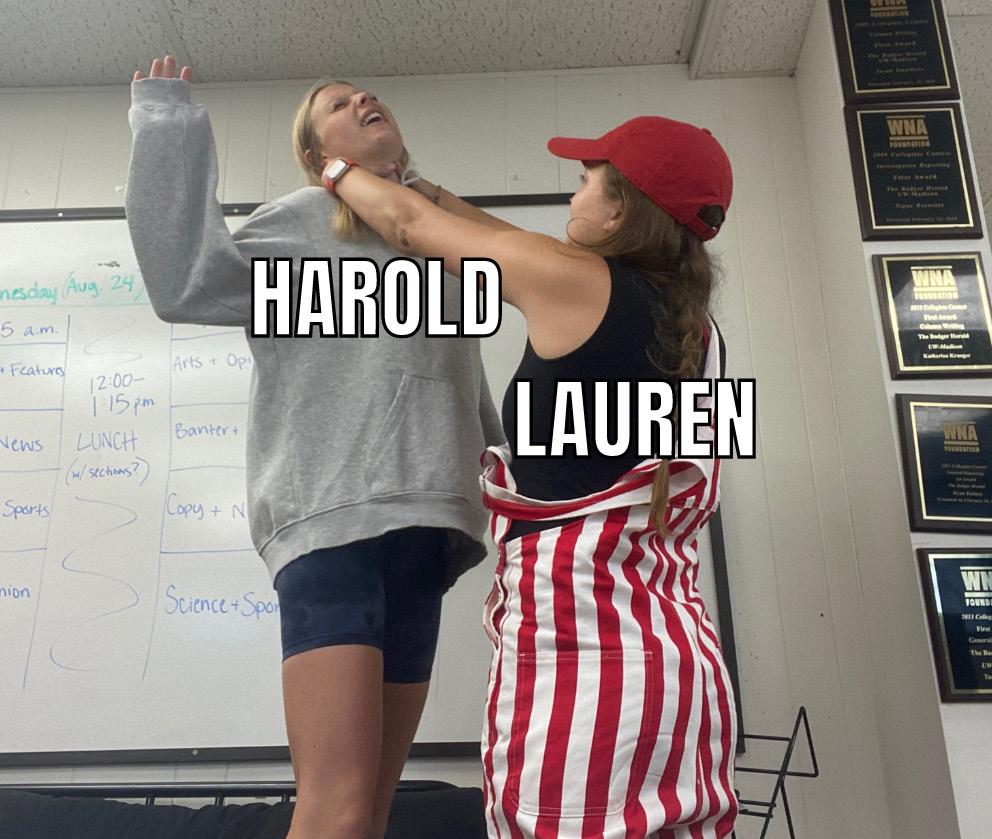
“Come on now, everybody knows ‘ducat,’” Harold said. “It’s used in ‘Hamlet,’ for chrissakes!”
“Stop it,” Lauren screamed, shaking Harold. “Shut your damn mouth.”
“You desire a simpler word?” Harold asked. “We can do that. How about, ‘junta’? A military group that rules a country after taking power by force?”
Lauren shook with anger. The man in the trench coat stormed past Lauren and Harold into the NYT office. One by one, the crowd followed. They had overtaken the building — a ‘junta,’ one might say.
Harold shuddered.
“Not easy enough?” Harold said. “How about ‘moooo’ with four ‘O’s? You know, the sound the cow makes?”
“We’re normal people, not idiots,” Lauren said, dropping the man. He landed on his butt and stayed there, looking confused as thousands of proletariat rushed past him to ransack the New York Times building.
The New York Times burned.
CAROLINE CROWLEY. THE BADGER HERALD. That moment when Lauren was fed up with Harold’s Wordle suggestions. #Laurenneedsangermanagementclasses. AUDREY THIBERT. THE BADGER HERALD. NYT could do literally any other five letter word. Okay, maybe not ANY other five letter word, but you get it. CAROLINE CROWLEY. THE BADGER HERALD. The New York Times burns after Wordle gets set as “GULLY.” A true tragedy. This is all Lauren — and the millions in the crowd that day — have to say to Harold. AUDREY THIBERT. THE BADGER HERALD. 22 • badgerherald.com •.September 13, 2022 BANTER @badgerherald
Badvice #2: Two college professionals give you scoop on housing
by Olivia Evans & Phoenix Pham Banter Editors
Should I room with my new friends?
“First week friends” — a common experience for college freshmen. You’ll form a friend group with the first people you meet on campus and force shared interests until it all falls apart in dramatic succession.
But, since leasing season is obnoxiously early in Madison, it’s a great idea to sign a joint lease with these people you’ve known for a total of four (4) days.
I nearly did this when I was a freshman and boy, do I regret not taking that leap. By week two of my freshman year, I realized my firstweek friends and I had vastly different morals, and promptly stopped hanging out with them.
But, I’m someone who likes fixing people, so they probably would have turned into a fun project for me had we ended up sharing an apartment. -Olivia
Can I quickly set boundaries with my
roommates via a good old-fashioned cage fight?

If you haven’t already shared a room with a sibling, then you should know the key to a good relationship with your roommates is setting expectations. How often should you clean the kitchen and the bathroom? Who does the dishes and when? Is it OK to share clothes? What is the policy on nudity? All these questions and a thousand more must be asked and answered during the length of your lease, and the simplest way to answer them is via cage fight.
The survivor gets to set the rules, the losers have to follow them. That’s what my roommates and I did when we first met. The funny thing is, my friends and I weren’t even planning on cage fighting at first. This new guy we picked up from Facebook, Derek, made us — I mean convinced us — to do it.
Man, Derek can be such a charmer when he wants to and is holding an apple peeler to your throat. I’ll be honest, cage fighting has a pretty steep learning curve, especially when you’re going up against somebody like Derek who has spent a couple years in prison. And it was a little awkward for the month or two that it took for our facial wounds to heal — who knew that you couldn’t grow a nose back? — but after a while, we got used to it. Now it’s just a normal part of life in the Derek Household. You disobey Derek? Get in the cage. Get it over with.
Obviously, Derek won and thank the Lord he did. A real natural leader, Derek. He lets us keep up to one-sixth of what we bring back from the grocery store ourselves, and we only have to do his homework two out of every three nights. Yeah, sure, he makes us cage fight each other over and over and over again
just to keep the excitement of our relationships alive, but honestly? That’s only made me a stronger person and a better friend.
Seriously, I know Derek and my roommates so much better now. Jacob loves to go for the reverse-suplex-knee-to-face combo. Matt cries like a baby when you kick his left knee. Derek is unbeatable. And after three years of this stuff, I find a sort of comfort in knowing my place in the pack hierarchy. It’s like knowing your zodiac sun sign AND rising, only better. I’m a beta omega male — that’s only three from being number one!!! I’m this close.
-Phoenix
How can I assert dominance over my roommate in a non-violent manner?
I once shared a room with a roommate who would sleep naked. This is a great way to assert dominance over whoever you’re cohabitating with. Waking up in the morning to see my roommate’s entire bare ass was definitely not how I expected to start my days. But, I will admit that I didn’t dare confront her about it. I let her continue this behavior, simply to avoid the potential awkwardness of that conversation.
To clarify, I’m not condoning showing your nude body to those you live with. In many cases, this would be considered harassment. But, as someone who’s been on the receiving end of this deal, it’s undoubtedly effective at making someone the Alpha Roommate.
-Olivia
Should I take advantage of poor plumbing to create an indoor compost heap?
One thing I have never regretted in all my years at college was building my own compost heap. It first started when I found that I had accidentally created a colony of poisonous fungi in my pantry by forgetting to put my Great Value Vanilla Yogurt and green grapes back in the fridge. But then it became so much more. After Derek locked me in the house for failing his calc 2 quiz, I got so bored I had just a little bite of that poisonous fungus. Once the initial seizures and projectile vomiting passed, I started to see things. See the TRUTH. Little machine elves that only I could see whispered all sorts of wisdom to me that only I could hear and I just knew I couldn’t let that fungus pile die. I had to worship it.
Now, I sacrifice everything to that fungus pile. Half of all the food Derek allows me. Dirty clothes, scraps of paper. The pantry isn’t big enough for it anymore, so I share my room with it. Just as it shares its wisdom with me.
-Phoenix
No advice given in “Badvice” should be followed or taken seriously. Please don’t engage in cage fights or sleep naked in a shared bedroom.
CAROLINE CROWLEY. THE BADGER HERALD.
September 13, 2022 • badgerherald.com • 23 BANTERfacebook.com/badgerherald
Are you new to college living? Are you looking to start an indoor compost pile? Here’s college housing advice from two seasoned vets
A glimpse into the challenging yet rewarding life of a cage-fighting roommate.

